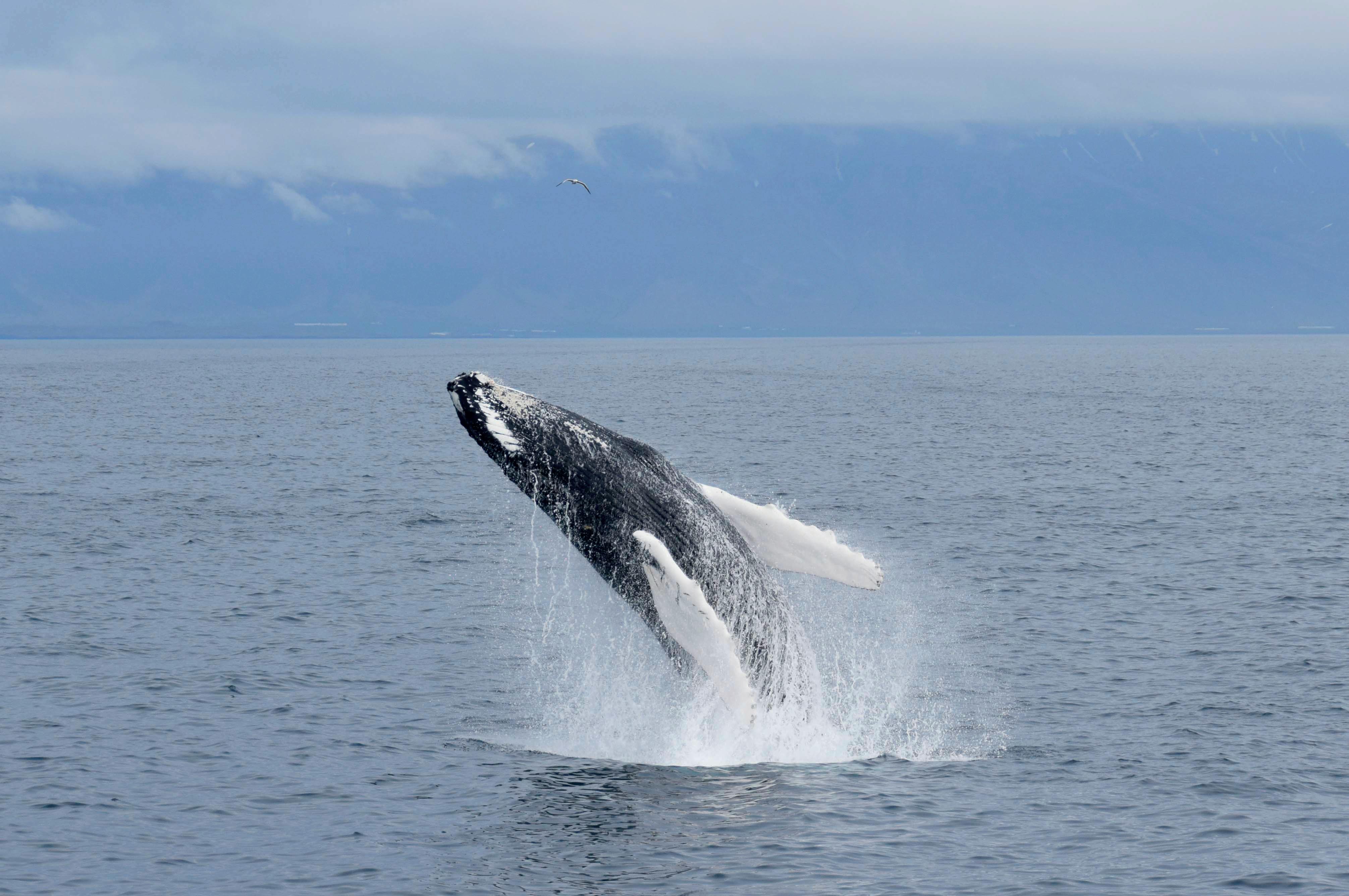














Welcome to Iceland!
Spring is finally springing (it tends to arrive a little later than in other parts of the world) and we couldn’t be more excited. The grass is getting greener, buds are blossoming, and the sun is shining. Well, when it’s not raining at least.
Speaking of the sun, as we get closer to the summer solstice in June, the days are getting longer and longer. By the end of May, there won’t really be a night to speak of, just a few hours of dusk. It’s what makes summer in Iceland so magical, the long summer evenings where sleep doesn’t seem necessary at all. While we do recommend sleeping, even during a vacation in Iceland, it often feels like you need a lot less of it during an Icelandic summer. The bright nights give you energy and waking up to a sunny morning makes it a lot easier to get up and head out to explore nature.

The What’s On Information Centre, Laugavegur 5.
WHAT’S ON — VOLUME 43 — ISSUE 5
Published by: MD Reykjavík ehf. Laugavegur 5, 101 Reykjavik. Tel.: 551-3600
Contact us: info@whatson.is
Publisher: Sigurþór Marteinn Kjartansson
Distribution: dreifing@whatson.is
Tel: 830-3629
Despite spring’s arrival, it’s still important to consider the weather forecast when travelling in Iceland, especially if hiking is on the programme. Icelandic weather can famously change at the drop of a hat, especially in higher altitudes. During this time of year, rivers have more water due to snowmelt and the country’s flora is at its most delicate. It’s therefore especially important to stay on paths by natural wonders. Also note that while summer has arrived in the city, it’s still winter in the highland. Many roads are still closed and it can get pretty cold.
Enjoy your time in Iceland. Explore nature, have fun, and stay safe!
Map of Reykjavík: Friðrik Bjarnason
Editor: Guðmundur F. Magnússon
Content writers: The What’s On Team
Ad sales: Reynir Elís Þorvaldsson, reynir@whatson.is
Printing: Printall AS
WHAT‘S ON IN REYKJAVÍK is published monthly, covering events and happenings in and around Reykjavík. Opinions expressed in WHAT‘S ON IN REYKJAVÍK are those of the individual authors. While every effort has been made to ensure the information presented is accurate, prices, times, dates and other information may be subject to change.

Scan code and book now

A visit to Iceland in May is full of opportunities. Winter depression has finally left the tired and winter-ridden bodies of Icelanders, people are getting excited for the upcoming summer breeze that already lingers in the air, and life seems to get easier! It is already bright nearly 24 hours a day in May, and the temperatures are slowly rising! Slowly, the local plant life reawakens to its vivid greenery, and the beloved puffin is back on our fair shores.
Here are What’s On’s tips for this month:
Ride an Icelandic horse. May 1 is the International Day of the Icelandic Horse.
Take a boat tour to see puffins. Those loveable, dorky seabirds are always a treat to observe!
While you are on a boat, you can also go whale watching—lots of migratory whales have returned to Iceland to feed in the nutrient-rich waters over the summer!
Take a road trip to Vík. The days are long, giving you lots of time to explore.
Stop to smell the flowers while walking through the Reykjavík Botanical Garden and grab a coffee in the cosy Kaffi Flóra Garden Bistro!
Soak up some culture by visiting local museums and galleries.
While you’re checking things off the list, snap some photos and tag #whatsonrvk on Instagram.


Visit our stores and experience Icelandic skincare powered by unique bioactive ingredients from the Blue Lagoon.
Find the store nearest you.
There are countless things to do in Iceland and it can often feel completely overwhelming to even
Here are a few recommendations from our expert staff at the What’s On Tourist Information Offices on

There’s a reason the Golden Circle is the most typical, classical tour in the country. It’s simply outstanding. Sure, you might not be beating the crowds or going beyond the regular hotspots, but you’ll have time to do that on your next visit! If you haven’t been to the Golden Circle, you should. If you haven’t booked your trip yet, you also…should!
Check out the selection of great tours we have on our website, ranging from budget friendly bus tours, to luxurious private experiences with plenty to indulge in!


gives you the chance to see humpback whales, minke whales and white-beaked dolphins. The bay is also full of birdlife. Surrounding landscapes offer a beautiful contrast to the vast sea, with stunning mountains on the horizon creating a picturesque backdrop.




Only 15 minutes sailing from the harbour of Reykjavík, you will find small islands Lundey and Akurey. On a specially designed boat, you can get close to the islands despite the shallow draft and observe the puffins with the engine of the boat off. A licensed guide will inform you about puffins and other birds observed, such as Northern Fulmars, Gulls and Arctic Terns.

Reykjavík is a simple enough city to navigate and it’s mostly walkable!
In our wonderful city you’ll find plenty of things to do and there are a few attractions in particular that we recommend, that allow you to quickly experience bits and pieces of Iceland.
Great warm up for your explorations outside of the capital area!


& Treat your taste buds at two historical food halls: Hlemmur 101 and Grandi at the old harbour.




Our first piece of advice if you have just one day to spend in Iceland is to change your flight and stay for at least a week. If that’s not an option, here’s what we suggest to get the most out of this unique destination in such a short time.
The Golden Circle is the most popular day tour from Reykjavík – and it’s easy to see why. The classic route includes three stops that also happen to be three of the most captivating natural wonders in Iceland. Tour operators may add their own twists, but you’re sure to stop at Þingvellir, a national park straddling the rift between the North American and Eurasian tectonic plates; Gullfoss, an awe-inspiring waterfall that lends its name to the Golden Circle (gull translates to gold); and the Geysir geothermal area, with an erupting hot spring guaranteed to impress. You can complete the Golden Circle in half a day (depending on the tour you book), leaving you time to squeeze more into your short stay.
The Reykjanes peninsula continues to remind us why Iceland is known as the Land of Ice and Fire. There have been eruptions on and off on the peninsula since 2021. The eruption sites are approximately an hour drive from Reykjavík and some of the recent lava fields are accessible to people that can handle hiking for up to five hours or so. Another option is seeing the lava fields from

the birds-eye by choosing a helicopter tour over the area. Seeing these freshly made lava fields first-hand is a spectacle and a reminder of nature’s fury. Please do not walk on the young lava fields, because lava takes years to fully cool down. There may be molten lava beneath the seemingly solid surface. Check out safetravel.is for the latest safety information regarding the Reykjanes peninsula.
If you want to see a glacier
There’s no better way to get a feel for the latter half of Iceland’s “Land of Fire and Ice” moniker than to go on a glacier hike. Glacier hikes are relatively easy and accessible for most, especially because professional gear is provided. You get to walk on a glacier with guides who know everything there is to know about glaciers and Iceland in general. What’s cooler than that?
If you want a little luxury
What’s better than a spa day? Visiting a geothermal spa fed by Europe’s most powerful hot spring, Deildartunguhver. At Krauma Natural Geothermal Baths, the water from the hot spring is mixed with cool glacial water for a perfect temperature. It has five hot tubs and one cold bath, plus a relaxation room, two steam baths and an infrared sauna. Alternatively, if you don’t want to leave the capital area, book the seven-step “Ritual” at the Sky Lagoon for a luxurious afternoon of soaking, steaming, scrubbing and other soothing activities.
If you want an adrenaline rush
Are you looking for a thrill? Go on a buggy ride. A buggy is a fast, sturdy and stable ATV, perfect for anyone who loves to get their blood pumping in the great outdoors – and who doesn’t mind getting a little dirty in the process. Driving a buggy through rough Icelandic terrain, over mud puddles, dirt roads or snow, makes for an exhilarating day.
If you want to hit the high seas
Marine life abounds in the water around Iceland, and you can see everything from harbour porpoises and white-beaked dolphins to minke and humpback whales on a whale watching tour. Tour boats depart Reykjavík’s old harbour throughout the day, cruising to the spots where sightings are most likely. Nothing beats the thrill of seeing a massive whale breach or watching one slap its enormous flukes on the water’s surface. If you have a few hours to spare before or after the cruise (or if you get seasick and a cruise is out of the question), check out the Whales of Iceland exhibition to learn more about these gentle giants.
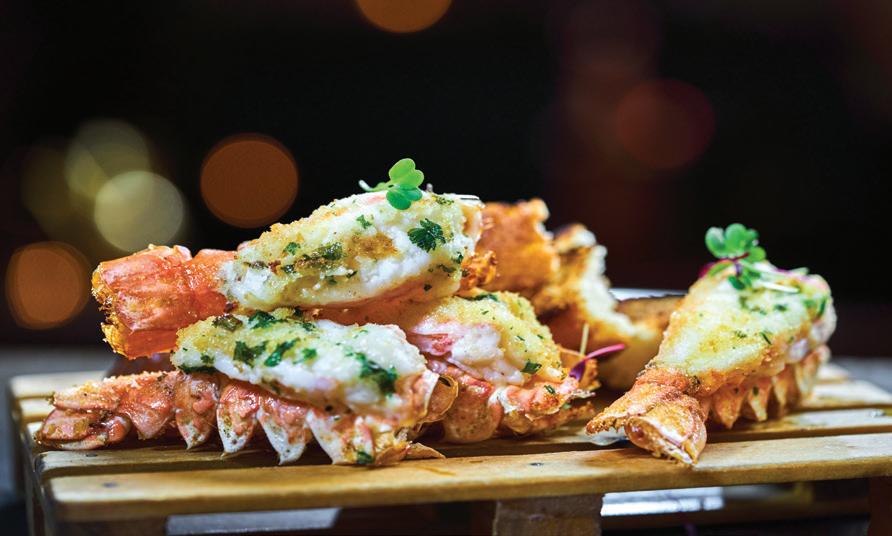


Stop by the What’s On information centre, or send us an email, info@whatson.is , and ask the staff to help you plan an unforgettable vacation.

Starts with a shot of the infarmous Icelandic spirit Brennivín


late night dining
Our kitchen is open until 23:00 on weekdays and 24:00 on weekends
Followed by 7 delicious tapas
• Smoked puffin with blueberry “brennivín” sauce
• Icelandic arctic char with candy beets salad, asparagus and elderflower-hollandaise
• Lobster tails baked in garlic
• Pan-fried blue ling with lobster sauce
• Grilled Icelandic lamb tenderloin with beer-butterscotch sauce
• Minke Whale with sweet potato mash and malt sauce
And for dessert:
• White chocolate "Skyr" mousse with passion coulis
12.900 kr.




With a subarctic climate and a tiny population, Iceland is a little different from other popular travel destinations. Desolate landscapes, extreme weather, mountain roads, geothermal areas, and the ocean can all catch the unprepared off-guard. Keep the following six safety guidelines in mind when planning your trip to Iceland.
1. Familiarise yourself with Iceland’s emergency numbers
The emergency number in Iceland is 112. You can dial it free of charge to reach emergency services like ambulances, rescue teams, and the police, and there is also a 112 app that can send your information to emergency services at the press of a button.
2. Follow updates on Safetravel.is
Icelandic weather is infamously fickle, and extreme weather is not uncommon. In wintertime, high wind speeds and snow can frequently limit visibility. Safetravel.is offers up-to-date road condition maps, weather alerts, and plenty of helpful tips and information on the best and safest way to travel around the country. There’s an app for that, too. It’s well worth downloading and checking regularly throughout your travels.
3. Be extra careful when visiting geothermal areas
The water in geothermal areas can reach temperatures upward of 100°C. Falling in or slipping can result in severe burns. Safe paths are clearly marked, so stick to them, and never walk on ground that is steaming.
4. Keep a safe distance from the ocean
Sneaker waves – disproportionally large waves that encroach farther onto shore than regular waves – are frequent occurrences at the Reynisfjara and Kirkjufjara beaches in South Iceland. Sneaker waves are more powerful than people expect, and accidents have proven fatal in the past. Keep a safe distance from the water and observe nearby signs.
5. Stay on the path
Whether visiting a waterfall, a geothermal area, or hiking in the mountains, staying on the marked footpath is imperative. Respect when paths are closed and heed all signs. It’s closed for a reason, either to protect you or fragile nature.
6. Let someone know where you’re going
If you’re planning on hiking or hitchhiking, let someone know where you’re going and when you’ll be back. You can also upload your travel plan to www.safetravel.is.





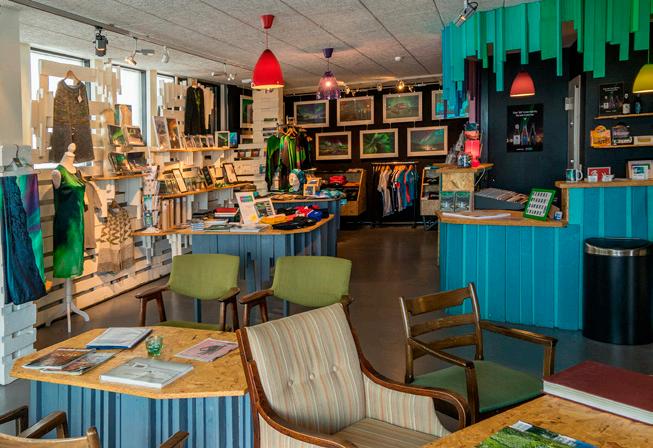









Location: Opening hours:
Show:
Price:

Harpa Concert Hall (-2 / K2)
Every day from 10:00 AM
Running every 15 minutes 2.990 kr. / $20


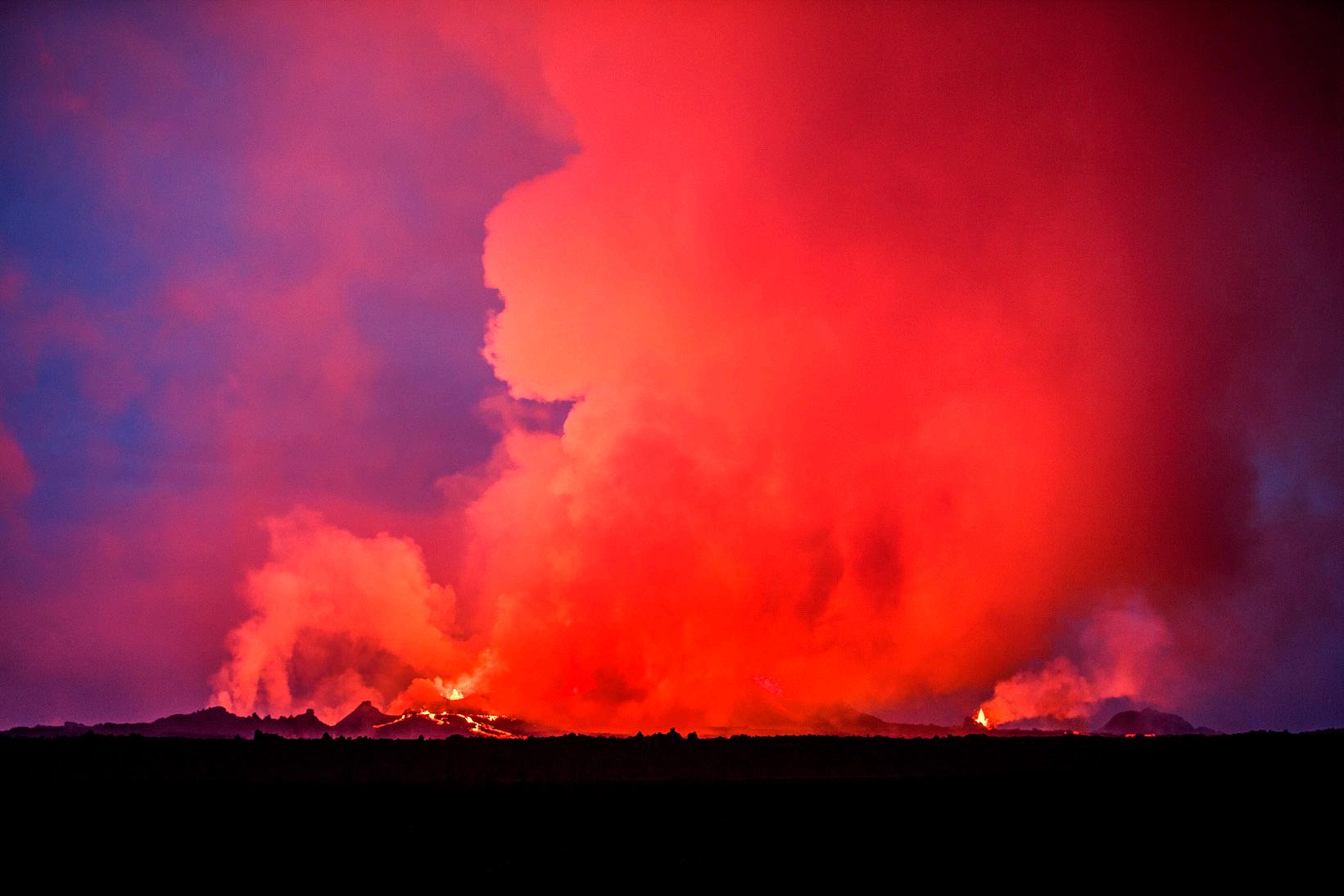
1. Liberty, Equality, Fraternity... Volcanicity?
The 1783-4 eruption of Laki was the biggest eruption in recorded history. An estimated 42 billion tonnes of poisonous gases and dust darkened the skies. Haze from the eruption floated east as far away as India, disrupting the monsoon season and leading to drought and crop failures. The famine that hit Egypt in 1784, was a result of the eruption, and killed roughly one-sixth of its population. Back in Iceland, an estimated 20–25% of the population died from famine, and over half the livestock was poisoned or killed by giant hailstones. Food shortages contributed to social unrest across Europe and contributed to the French Revolution of 1789 that gave birth to western democracy.
2. And in second Place…
Iceland was also the site of the second biggest emission in recorded history: the 2014 eruption of Bárðarbunga. In just 6 months, Bárðarbunga produced enough lava to cover the island of Manhattan - 85km2
3. Enter the Volcano
In Jules Verne’s Journey to the Centre of the Earth, the heroes climb down a crater on the Snæfellsnes peninsula to find vast oceans filled with extinct prehistoric creatures. While an encounter with a herd of mastodons is unlikely, a trip to Þríhnúkagígur (Thrihnukagigur) still feels pretty Jules Verne. Þríhnúkagígur is the only volcano in the world

where you can descend into the magma chamber. Discovered in 1974 and opened to the public in 2012.
4. New Earth
Surtsey, Iceland’s most southern point was formed by a volcanic eruption at the bottom of the ocean and emerged from the water on November 14, 1963. It was immediately granted protection by law, and to this day, only scientists are allowed to go there, and even they have to get special permission. This means that we have been able to monitor how life settles on a brand-new land from the beginning, which has, of course, been invaluable to scientists.
5. SuperFresh Lava
Iceland has a third of the world’s fresh lava. ‘Fresh’ is a relative term that may need defining. When discussing Arctic Char, it’s best measured in hours. In geological time fresh lava means lava that’s less than five hundred years old. Iceland is full of these ‘Here’s one I prepared earlier’ landscapes offering snapshots of geological time and processes.
6. Icelandic volcanoes are on the move!
Due to changes in on the tectonic level of the earth, Iceland’s volcanoes are actually moving east. Veeeeeeeery slowly. If you visited Iceland 20 million years ago, the volcanoes would all have been situated in the West Fjords. Fifty million years ago, during the Eocene epoch, you would find our volcanoes living happily in Greenland, and 70
million years ago, our volcanoes would have been terrorising dinosaurs somewhere in Canada.
7. Iceland has had volcanic eruptions every year since 2021
The island has somewhere between 150-200 volcanoes, split into different volcanic systems. About 30 different systems are still considered “active” in Iceland, and 13 of them have erupted since the Viking Settlement in 874. The current “wave” of eruptions began in Fagradalsfjall on the Reykjanes peninsula in 2021. Geologists believe this current phase could last decades, if not centuries - a powerful reminder of nature’s might!




















One of the first things you’ll discover upon visiting Reykjavík is that it’s very walkable. The majority of the city’s restaurants and shops are located along two streets – Skólavörðustígur and Laugavegur. If you want to explore the city beyond the confines of these well-trod roads, we have a few suggestions. Stretch your legs on these three walks in and around Reykjavík.
Smack-dab in the middle of town, you’ll find Tjörnin, Reykjavík’s central pond. We recommend starting this walk at the north end of the pond, where the ducks congregate and take a clockwise route.
You can start with greeting the ducks. If you have a snack for them (heed the signs about when it is and isn’t allowed to feed the ducks), a few may even swim alongside you on the first stretch of your walk. Take the lower sidewalk and cross over Skothúsvegur to leave the roadside and enter Hljómskalagarður park.

While looping around the southern end of the pond, you’ll see the octagonal Hljómskálinn pavilion, the first structure in Reykjavík built for music events; a statue of beloved poet Jónas Hallgrímsson, and a sculpture garden showcasing the works of some of Iceland’s most renowned female sculptors.
Once you’ve crossed back over Skothúsvegur on your way back to City Hall, you’re at the spot with the best views over Tjörnin. Along this stretch of the walk, you’ll find the statue Úr Álögum, one of Einar Jónsson’s phenomenal statues decorating the
city. This one depicts the tale of Saint George and the Dragon. There’s also a park bench at this point in the walk with a bronze likeness of poet Tómas Guðmundsson and a QR code you can use to listen to a reading of his poem “Hotel Earth”.
Finish your walk with a visit to Reykjavík City Hall, where a massive topographic map of Iceland is often on display. Finally, exit City Hall via its long footbridge over the end of the pond, snap a picture with the Monument to the Unknown Bureaucrat and head off to your next adventure.
Distance: 1.5 km
The coastal path running east from the Harpa Concert Hall is named the Sculpture and Shore Walk. While it is dotted with some lovely art, it’s also an excellent path to walk, jog or cycle to get that fresh sea air in your lungs and sweeping views of Esja forever imprinted on your soul – it’s a stunning mountain.
But let’s talk about the art. The walk starts at the Harpa, as mentioned above, so it should be pointed out that it is a work of art in its own right. Its iconic glass facade is the creation of Icelandic-Danish artist Ólafur Elíasson. Explore the interior and be sure to look up for a complete immersion in the majesty of the building.
On with the walk. The first sculpture you’ll encounter is the beloved Sólfar, or the Sun Voyager. While it’s often mistaken for a Viking ship, artist Jón Gunnar Árnason created it as a sun ship, meant to convey a dream of hope, progress and freedom. It was unveiled on August 18, 1990, to commemorate Reykjavík’s 200th birthday.
Walking along, you’ll encounter Pétur Bjarnason’s sculpture Partnership, which has a twin in Miami, U.S. The sculptures were made to commemorate 50 years of diplomatic relations between Iceland and the United States. Further along is Jóhann Eyfells’ Íslandsvarðan sculpture, which was completed in 2006 by pouring liquid metal into moulds the artist dug in the earth.
A personal favourite sculpture of this writer is Shore Piece by Sigurður Guðmundsson. It’s the largest piece displayed along this route, so you shouldn’t miss it.
Continue to the bright yellow Höfði lighthouse, and cross over Sæbraut to see Höfði House, where former Russian and U.S. presidents Mikhail Gorbachev and Ronald Reagan met in 1986 to discuss the end of the Cold War.
From here, either retrace your steps or cut up
Katrínartún to Laugavegur and hang a right to meander back to the city centre.
Distance: 1.5 km from Harpa to Höfði House
If your idea of a walk means venturing off paved paths, head to Öskjuhlíð. Perlan tops the wooded hill on the outskirts of the city centre, and it is a lovely forest to wander through. It’s crisscrossed with rough paths, mountain bike ramps and massive rocks that are undoubtedly the remains of poor trolls that got caught out in the sun.
Öskjuhlíð was used as a lookout by British and American soldiers during the Second World War, so you may come across some abandoned bunkers during your walk. Signs have been erected explaining the history of the bunkers.
Spend an hour wandering among the birch and pine trees, or continue down to Nauthólsvík geothermal area and follow the path due west to follow the seaside around the Reykjavík airport, heading back into the city centre when the path joins up with Suðurgata.
Distance: Varies


The DIY approach is all fine and good, but sometimes you want someone to guide you and regale you with fascinating trivia while you walk. If that’s more your speed, check out Reykjavík walking tours on WhatsOn.is. Happy walking!


of puffin in the world. Holding court in the Pacific Ocean are the stunningly quaffed Tufted Puffin and the Horned Puffin, which look very similar to their Atlantic cousins save for a black horn of skin above the adults’ eyes.
The three puffins are auks, birds that are excellent swimmers but far less skilled on land. As auks, puffins are related to the great auk, which went extinct in 1844 when the last two birds were hunted on Eldey, a rocky island off the coast of Iceland’s Reykjanes peninsula.
Specifically, the Atlantic, horned, and tufted puffin are of the genus Fratercula, Latin for “little brother.” The name refers to the bird’s black and white plumage, which makes it appear to be wearing monastic robes.
We will focus on the Atlantic puffin from here on.

The Atlantic puffin nests in colonies each summer on the shores of Iceland, Norway, Greenland, Atlantic Canada, and the Faroe Islands, but they spend their entire winters at sea.
Not much is actually known about what puffins do at sea all winter, though it is known they can drink seawater and dive for fish to eat. While adult puffins return to their nesting sites every spring, younger puffins spend a couple of years out at sea before coming ashore to find a mate.
The birds’ colouring is ideal for avoiding predators while at sea. When viewed from the air, their black backsides blend in with the dark ocean, while their white stomachs look like the sky shimmering through the water’s surface to any larger sea creatures looking for food.
While wintering at sea, puffins moult their feathers (to the point of making them unable to fly for a few months) and the colourful portions of their beaks. Their beaks, as a result, are far less bright and less broad, and they also lose the black colouring around their eyes during the winter months.
All that being the case, wintering puffins look pretty different from the colourful creatures we love seeing in Iceland each summer.
Take a puffin tour from Reykjavík harbour, and you might be surprised by how quickly puffins flap their wings. If you can’t count fast enough, it is a lightning-quick 400 beats per minute. They often fly close to the water’s surface, reaching speeds of up to 88 km/hr.
What is more, they use those very capable wings to propel themselves under the water. Puffins dive to 60 metres to catch sand eels, which they bring back to their burrow for their mate and puffling.
While they are fast flyers and deep divers, what puffins are less adept at is landing. If you do take a puffin tour, you’re sure to get a chuckle out of watching them belly-flop onto the water or crash into the waves. They’re similarly clumsy on land, which, in addition to their colourful features, earn them the nickname “clowns of the sea.”
When young puffins are nearing the age when they should be able to leave the nest and fend for themselves, puffin parents give them a push by stopping bringing home food for them. Once the hunger sets in, the young puffins leave their burrows with the intention of hitting the sea and diving for fish. Unfortunately, that journey doesn’t always go off without a hitch.
Many young puffins leaving home for the first time on the Westman Islands get distracted by the lights in the nearby village and fly toward them instead of the sea. It’s such a common occurrence that it’s a tradition for the children of the Westman Islands to roam the streets throughout August and September, looking for young puffins who got lost in town. They scoop up the birds and give them a cosy box to spend the night in, finally setting them free when the sun rises the following day.
The International Union for Conservation of Nature (IUCN) categorised the Atlantic Puffin as a vulnerable species in 2018. It is estimated that there are some 10 million of the seabirds in

Bíó Paradís is Iceland’s first and only art-house cinema, located in the heart of downtown Reykjavík. We screen the latest independent movies from around the world, as well as classic cult films and local Icelandic filmsmany with English subtitles.

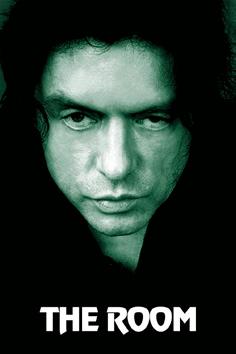
We provide a warm, cozy environment for film lovers of all kinds, both in our three-screen cinema and in our well-stocked bar & café. Join our legendary weekly Party screenings - sometimes we Sing-Along. You can also just drop in for drinks and snacks, our ice-cold beer is on Happy Hour every day between 5-7 pm. A true haven for those seeking thoughtprovoking films and vibrant social gatherings!
Friday May 9 @9pm
Paul Thomas Anderson’s potent epic about oil and greed starring Daniel Day Lewis pushes at the boundaries of cinema!
THE ROOM (2003)
Friday May 16 @9pm
A story of love & betrayal that will TEAR YOU APART! A one of a kind cult movie that should not be missed as a cinema experience.



Friday May 23 @9pm
The story of Sandy and Danny’s summer love and various adventures of guys and gals at Rydell High - we’ve got chills! Join the party and sing-a-long with us!
ALIENS (1986)
Friday May 30 @9pm
Ripley, the sole survivor of the Nostromo’s deadly encounter with the monstrous Alien, is sent back to LV-426 with Marines to find themselves battling the Alien




ICELANDIC LAMB IS THE FIRST ICELANDIC FOOD PRODUCT TO BE PDO-MARKED
Icelandic lamb has acquired the PDO label, the highest level of geographical indication in Europe, placing it in the company of the world's best-known and most sought-after quality products.

What does it look like?

It looks like a giant white …finger. Yes. Finger. The Hallgrímskirkja church is probably the best-known landmark in Reykjavík, along with Perlan. It’s the last work of architect Guðjón Samúelsson, one of the most prolific architects of Iceland. His work usually drew inspiration from Icelandic nature in some way and Hallgrímskirkja is no exception, conjuring the mountains and glaciers of Iceland along with the iconic columnar igneous rock. Guðjón started sketching the church in 1937 and they started building it in 1945. It wasn’t completely finished until 1986, although parts of the church had been ready for a long time at that point, even consecrated so the unfinished church could be put to use.
Why is there a Viking statue in front of the church? It’s thanks to the Americans, actually. They gave us the statue to commemorate the thousand-year anniversary of Iceland’s parliament, Alþingi. The statue is a likeness of Leifur Eiríksson, or Leif the
lucky, the Norse Viking that is rumoured to have been to America centuries before Christopher Columbus. It might seem strange to place a Viking statue in front of a church, but actually, it was the other way around. The statue got there in 1932, but they didn’t start building the church until 1945. Another thing about the location of the statue, it is in the heart of Reykjavík today, in front of Reykjavík’s most famous landmark, but in 1932, the churchless hill was on the outskirts of Reykjavík, most of the town’s inhabitants lived down by the pond.
You take the elevator! For a small fee, you’ll be rewarded with a view to die for. Hallgrímskirkja is the second tallest building in Reykjavík and seeing the rows of the multi-coloured houses in the centre all laid out neatly like doll’s houses, and further away, the bright blue sea and mount Esja, is really something you shouldn’t miss.
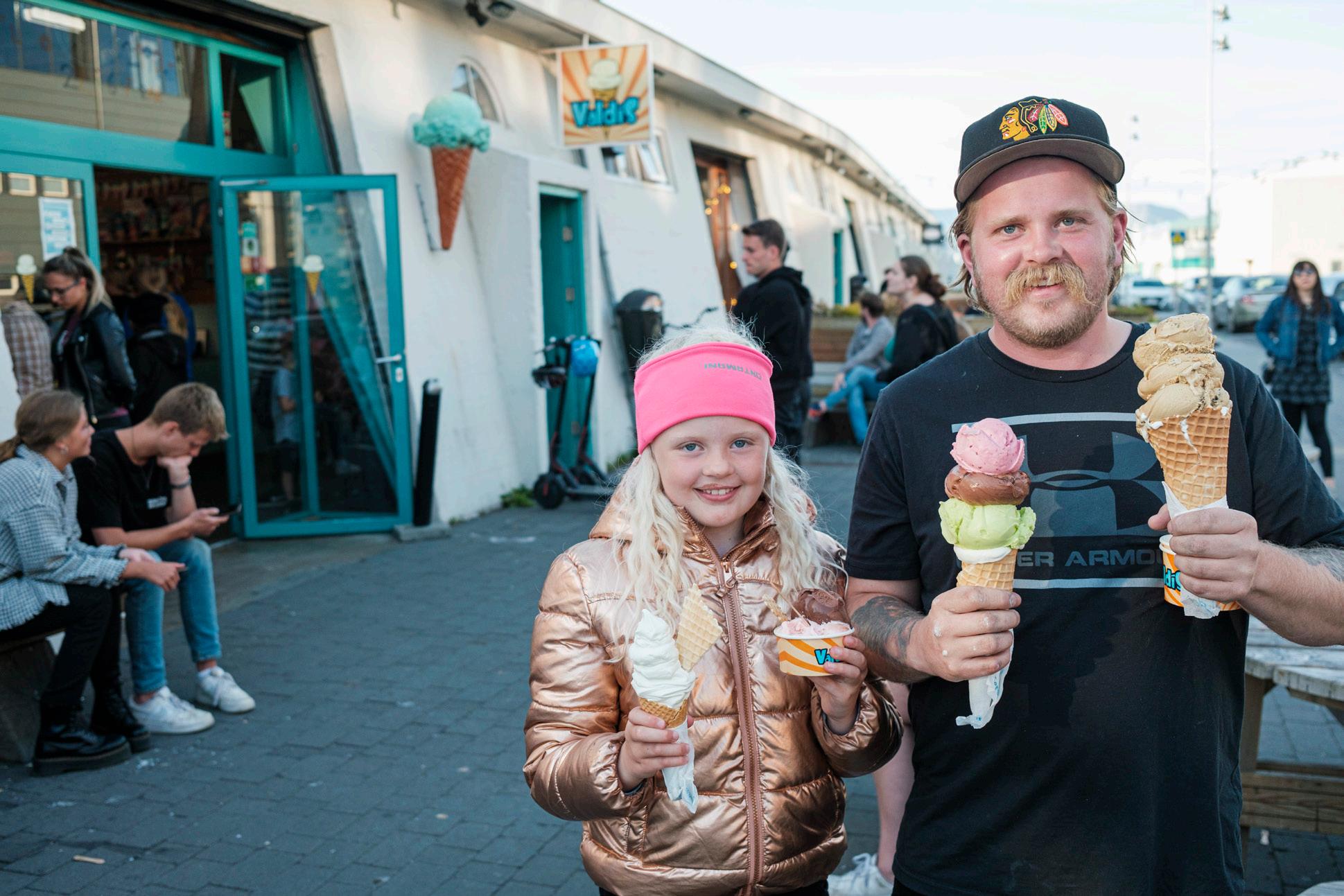
In Iceland, soft serve is the name of the game, and mixing your favourite toppings requires serious thought. A swirl of ice cream in a cone dipped in a chocolate shell is a classic, but most parlours also serve up milkshakes and bragðarefur, which are cups of soft serve blended with mix-ins of your choice, from fresh fruits to nuts and candy.
Spend a day lazing about at Austurvöllur square
On sunny days, everyone who is anyone heads to Austurvöllur. The square in front of the Parliament building quickly fills up with picnickers enjoying a beer or ice cream or simply relaxing in the sun. The cafés surrounding the square fill up even faster, and the hunt for a table can get brutal during mealtimes!
What is the best thing Icelanders do with their abundant geothermal reserves? Heating their swimming pools, of course. Iceland’s public swimming pools are a beloved luxury that Icelanders put to good use. On any given day, you will find kids splashing about or flying down waterslides, teenagers discussing pressing matters
of life and love in a quiet spot, and adults getting their laps in. The most important part of the swimming pool is the hot tub, where people from all walks of life gather to discuss society, the latest political scandals and the weather.
Catch a bus or take a short drive out of the city and go hiking! Be sure to wear some good boots and warm layered clothing whenever hiking in Iceland. The weather is fickle, and forecasts can not always be trusted! If you do not feel like going out of the city – or do not have the time – there are plenty of great hiking trails right in the city. Try the paths around Öskjuhlíð, Grótta, Elliðaá or Rauðavatn. They are all accessible by bus.
You may be in the far north, and the thermometer may not be displaying the sweltering summer temperatures you are used to, but you can still get a sunburn in Iceland. So be sure to slather on the SPF before soaking up the Icelandic sun.


This









unique to the island, modern day Icelandic sheep are also direct descendants of the livestock that arrived with settlers in the 9th century. As such, they boast some characteristics that have long since disappeared from their relatives in Europe. Like their ancient forefathers, the Icelandic sheep are double coated, with an outer layer of long, coarse hair called ‘tog’ that repels water, and a short, soft and fluffy undercoat called ‘þel’, which is a perfect insulator. This is a big part of what makes Icelandic wool –and the garments made with it – so special.
There have been innovations in Icelandic wool. For instance, the two coat layers used to be separated by hand (a very labour-intensive process) and used for different purposes. In the 1920s, however, quicker new methods of processing the wool were created and Iceland’s famed ‘lopi’ – consisting of the two coats spun together to produce strands that are simultaneously light, warm, tough and waterproof – was born.
It’s colourful
Icelandic sheep have always been bred in a variety of colours, and some farmers even pride themselves on preserving specific colours. The result is Icelandic wool being produced in as many colours as there are sheep, with the most common colours
being black, white, various shades of brown and grey. Besides these classic “sheep colours”, lopi can also be found dyed in every colour of the rainbow.
That double coat mentioned above gives lopi its dual-fibre structure, making it perfect for knitting garments that are warm, waterproof and light. Whether you intend to knit a scarf or try your hand at the intricate patterns of a famous Icelandic lopapeysa, lopi is ideal. Not only is it beautiful, it’s also easy to knit with (the loose-spun wool can be twisted back together if broken) and it felts easily. As any Icelandic child will tell you, lopi is scratchy right against the skin, so it’s best used for outer layers of clothing – unless you get your hands on some lambswool, that is.
By “magical” we mean it’s self-cleaning, which is just about as close to magic as it gets for any parent trapped in an endless laundry cycle. Lopi garments need to be hand-washed, but it almost never needs to be washed. Thanks to the structure of the hair fibres, lopi doesn’t hold bacteria like
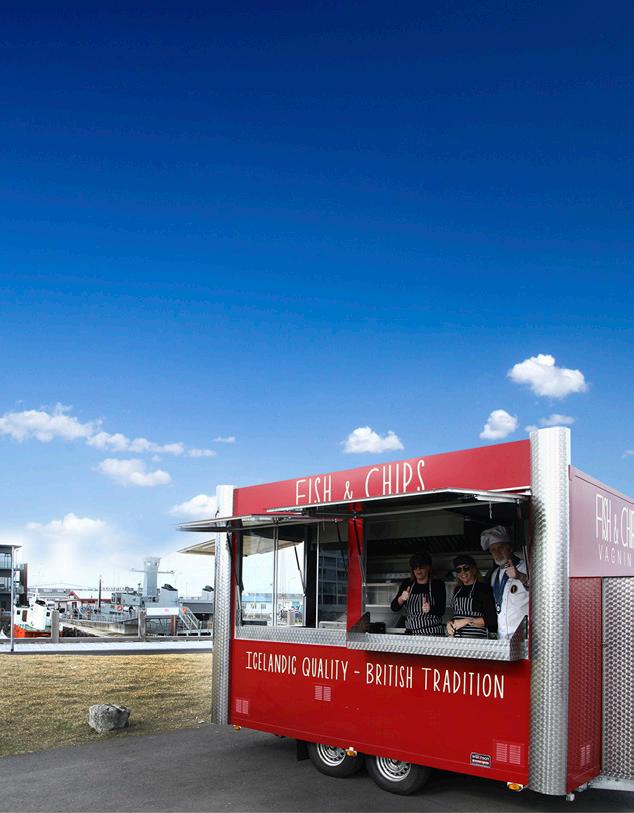
cotton or synthetic materials do. So the only time you might need to wash your woollens is when they get stained (which is also rare, since they’re fairly waterproof). So just air them out and call it a day. Another of lopi’s magic tricks – one we absolutely do not recommend trying indoors or while wearing the lopi in question – is that it doesn’t burn. It may light up if you put it right in a flame, but it will selfextinguish once you take it out. Amazing!
It’s versatile
Icelandic wool looks great just about any way you knit it. And if you don’t knit yourself, just check out the range of products Icelanders have made with their wool as proof of its versatility – and its beauty. You can find everything from simple hats and mittens to the colourful scarves and blankets by Vík Prjónsdóttir. Of course, the most popular wool garment in Iceland is the Lopapeysa, the classic sweater with intricate and unique patterns around the yoke. An infinite range of classic lopapeysur can be found at the Icelandic Handknitting Association, while Farmer’s Market boasts a fashion-forward take on the classic.

The Fish & Chips Shop is a family-run restaurant. Our fish is freshly caught on our own boat and processed in our plant, ensuring an unbroken chain of quality.




Reykjavík is a great city, and we wholeheartedly recommend spending some time there, just not all your time. Iceland is at its very best during these short summer months, and you simply need to leave the city for a while and take it all in.
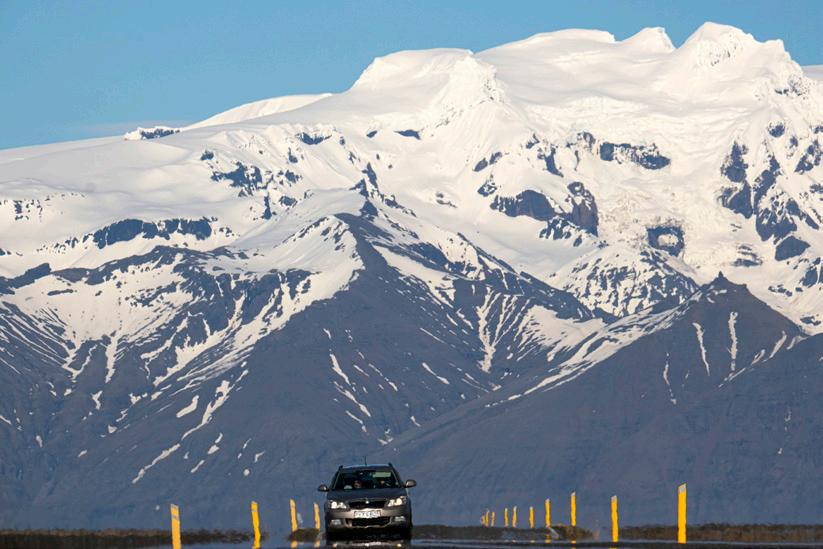
There are a few ways to get out of town, depending on your preferences. If you’re unfamiliar with the country and want to learn more, taking a guided tour might suit your needs. Reykjavík tourism companies offer tours almost all over the country, some short enough to fit into your afternoon, others longer, so just figure out where you want to go and book your trip.
If you prefer a little more freedom to explore on your own, renting a car is a comfortable option, allowing you to travel at your own pace. Just be careful: conditions in Iceland might be different from what you are used to, even in summer. Be sure to check out Icelandic driving regulations and check the weather forecast before you set off.
If driving on your own feels a little too risky, you can always take the bus. The city bus company, Strætó, will take you to some of the larger towns around the country. Other bus companies will take you to great hiking spots or all the way around Iceland.

Almost wherever you go, you’ll find natural wonders, lovely little towns and all the untamed Icelandic nature you can imagine. Certain regions do have their specific charm, however, so depending on your needs and preferences, here are some destination suggestions.
One of the most popular destinations in Iceland is the south coast . This stretch of land between the coast and the mountains is an exercise in contrasts. Verdant farming communities meet jet-black sand beaches, towering glaciers cover imposing volcanoes, and still and clear lakes reside next to thundering waterfalls and erupting geysers.
If you don’t have the time to stray too far from the city, exploring the Reykjanes peninsula might be just up your alley. Just a short drive away from the city, this area has still lakes, lava fields, and colourful geothermal areas as well as charming little fishing villages.
The Snæfellsnes peninsula is often described as a microcosm of Iceland. Black beaches, hot springs, charming fishing villages, and the majestic Snæfellsjökull glacier overlooking it all are sights that are not to be missed!
If you have the time (at least four to five days), you can even drive all the way around the country. Route 1, or the Ring Road follows most of the coastline of Iceland and connects most of the major towns.
If you have a car, you might just want to find a town to stay in and explore the surrounding region. During the summer season, many towns host festivals that are well worth checking out. Some of the big festivals include Fishermen’s Day at the beginning of June and Icelandic National Day on June 17.
If you’re feeling active, go hiking in Iceland at the end of June. Not only is there a chance of good weather, but popular hiking trails in the highlands are only open in summer. The most popular multiday hike is the Laugavegur hiking trail, which usually opens in late June, but if you can’t wait that long, hiking up Mt. Esja or the hot spring-filled Reykjadalur valley are great day trips close to Reykjavík.
If you’re simply keen to explore the nature and landscapes of Iceland, driving around the country, stopping for hikes and picnics, is a great way to spend your days. Look for the sign with a square with looped corners indicating interesting spots ahead.
If you want to be prepared for your trip, contact the What’s On office on Laugavegur and get some advice!

Íshestar has been offering horseback riding tours in Iceland since 1982, welcoming riders of all levels to explore Icelandic nature on our friendly Icelandic horses. Ride through stunning lava fields, rolling hills, and breathtaking landscapes just 15 minutes from Reykjavík city centre.

Established in 1982 – We have over 40 years of experience providing horseback riding adventures.
We offer a wide range of short rides, like the Lava Tour through lava fields, the Horses and WafflesTour with a sweet treat afterward, the Viking Tour for a powerful adventure, and Private Rides.
Beginners & Experienced riders welcome

Experienced Guides – Our knowledgeable, multilingual guides ensure a safe and enjoyable experience for all riders.
Sörlaskeið 26, Hafnarfjörður
354-555-7000
www.ishestar.is
info@ishestar.is




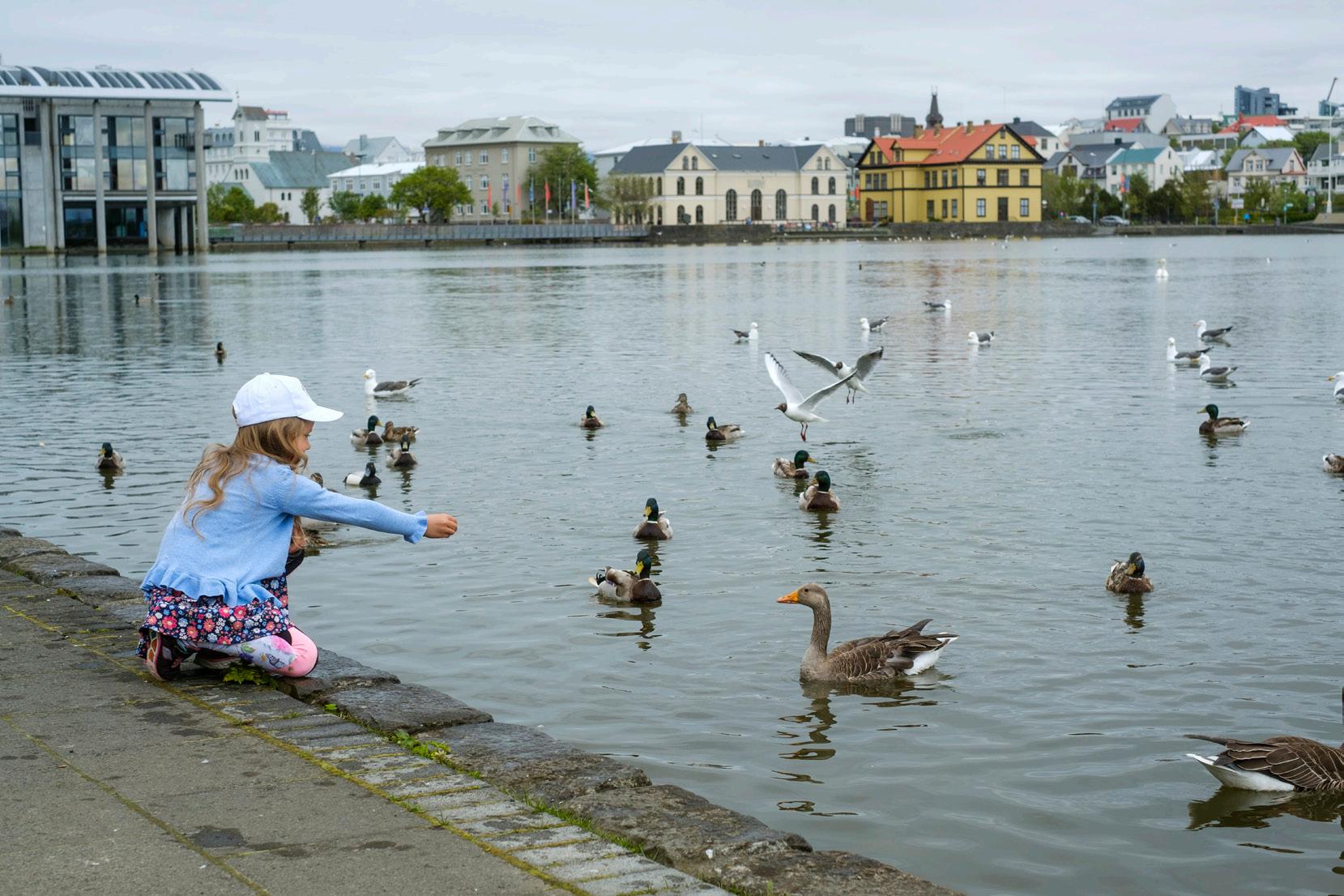
Reykjavík is an amazing place to travel with kids at any time of year. It’s bursting with colourful houses, squares and parkettes, and interactive museums that encourage young (and old) imaginations to flourish.
Here are a few of our favourite things to do with kids in Reykjavík.
We’re of the opinion that you’re never too young for museums. Reykjavík has a lot to choose from, but those that we’ve found to be most kid-approved have an interactive element or two.
The Maritime Museum will teach the whole family about Iceland’s fishing tradition from the olden days up to modern times, while allowing kids to dress up like fishermen, go on a scavenger hunt through the exhibit, and try their hand stacking crates of fish with a forklift.
The Settlement Exhibition Reykjavík 871±2 is another family favourite. Built around the remains of a Viking longhouse excavated smackdab in the middle of Reykjavík, the museum tells the story of Reyjavík’s settlement (in the year 871, give or take
a couple years) with interactive screens to learn more about the rocky remains. There’s also a room where kids can dress as Viking settlers and play old games.
Also great for families travelling with younger members are the Árbær Open Air Museum, with its turf houses and olden-day charm, and the National Museum of Iceland, which has a room for families to enjoy.
Reykjavík’s central pond, Tjörnin, is home to a healthy population of ducks, geese and swans, in part thanks to its proximity to Vatnsmýri, a protected wetland and bird sanctuary, to the south. A stroll around the pond is a great way to spot the pairs of ducks floating around and doing their thing.
Feeding bread to the ducks is frowned upon – and not allowed at all over the summer when ducklings arrive – but if you happen to have frozen peas or birdseed in your pocket, feel free to toss that for your new beaked buddies.
Expect to see mallards, gadwall, greater scaup, tufted ducks and teal, plus greylag geese and

swans. There’s also a sign on the north end of the pond (by City Hall) with descriptions of some birds you might spot in the area.
Iceland’s thermal pools are good for swimming laps and lounging around in, but they’re also tons of fun for kids. Many locations have kids’ pools, with fountains and slides for the littlest ones, and bigger kids will get a thrill out of the bigger slides with their twists and turns.
Just remember: shower with soap before suiting up and jumping in.
Even if you’re not a family of avid equestrians, you can enjoy a day on horseback in Iceland. Icelandic horses are known for their calm and friendly nature, making them perfect for inexperienced adults or children to ride – plus they’re shorter than horses you find in other parts of the world, so climbing into the saddle is less intimidating an experience.
Always check the minimum age requirements before booking a riding tour, but some will welcome kids as young as 7-years old. It’ll be an unforgettable experience for kids of all ages.
Introduce your kids to whales while in Iceland. A number of whale watching tours depart from Reykjavík’s old harbour year-round, taking you out on Faxaflói Bay for a chance to spot humpback whales, minke whales, white-beaked dolphins and harbour porpoises.
There’s a real thrill in the hunt, and the excitement onboard goes through the roof at the sight of a humpback’s mighty fluke slapping the water. Go later in the spring or during the summer to also see puffins, which are not the most graceful of birds –kids and adults will get a laugh as they crash-land on the water’s surface.
Kids that don’t have the patience (or the stomach) for a three-hour tour might opt for a visit to Whales of Iceland, where they can come face to face with the true scale of the gentle giants of the sea, learn about whales and play on the orca-themed climbing structure.
For an activity that your kids will be ooh-ing and ahh-in over long after you’ve departed Iceland, take them inside a glacier. A tour atop Langjökull glacier and into a man-made tunnel dug into it a few years back is a suitable adventure for the whole family. Those travelling with adventurous kids 6-years or older are also able to take a tour of the natural ice cave in Katlajökull glacial tongue, part of the glacier covering the mighty Katla volcano.
Don’t feel like schlepping to a real glacier? Perlan has brought the ice cave experience to Reykjavík. Just catch a shuttle to the glass-domed building on Öskjuhlíð to visit Perlan’s Ice Cave and Glacier Exploratorium, the world’s first indoor ice cave. There’s also an ice cream parlour and cafe at Perlan, which you definitely won’t find atop a real glacier.
If it’s a nice day to spend outdoors, there are few better places to be than in Reykjavík’s Laugardalur neighbourhood. Take the kids to the Reykjavík Family Park and Zoo to meet Icelandic farm animals, plus foxes, seals and reindeer. Let them run wild and jump on the air trampoline in the park’s expansive play area, and then wind down with a stroll through Reykjavík’s Botanic Garden. It’ll be a day well spent just outside the city centre.
If you’re spending a day or two exploring Reykjavík’s museums and swimming pools, consider buying the Reykjavík City Card. Available for 24hr, 48hr, and 72hr periods for kids and adults, it gives you access to museums, swimming pools, public transport, and more at one low price.

Visit the Lava Centre
Are you curious about the latest eruptions on the Reykjanes Peninsula?
Learn more about the activity near Grindavík and the Blue Lagoon at Lava Centre










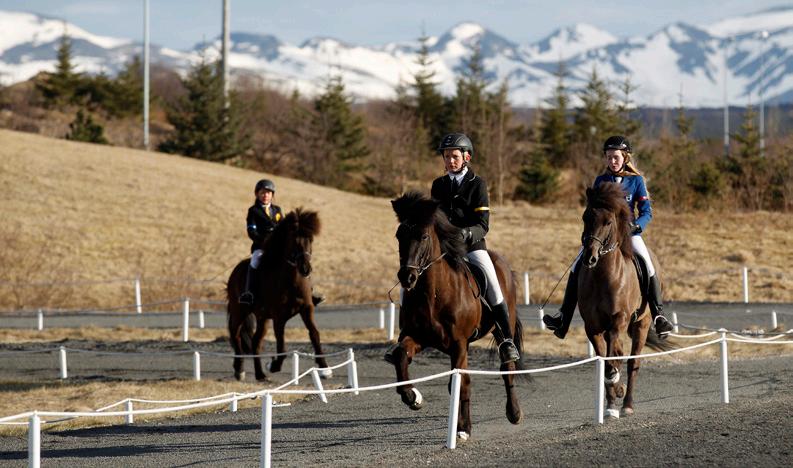
home and abroad for being easy-going and friendly. Like well-trained dogs. This is funny, considering how impolite some Icelanders can be – the language does not even have a word for “please.”
Their temperaments can be attributed to nature, since their genetics are so protected (more on that later), or nurture since Icelanders tend to treat their beloved horses like members of the family. So, their relaxed attitudes may just be a result of the horses’
The Icelandic horse is also unique in that it is one of only a few breeds in the world that can perform five gaits (ways of walking), while other breeds can only
The three common horse gaits are walk, trot, and canter, but the Icelandic horse can also pace and tölt. Tölt is a four-beat lateral gait that is entirely unique to the Icelandic horse. It is a sped-up version of walking, but much more impressive as the horses
lift their front legs up high, with only one hoof touching the ground at any time.
Tölt is a very useful gait for Iceland’s often uneven ground, providing a steady ride. It was presumably the gentlest on the riders’ backside back when horses were the main mode of transportation.
That said, not all Icelandic horses can tölt, and those that can are usually trained to do it properly. So, when you take a riding tour, be sure to ask for a horse that can tölt so you can experience this truly unique trait of the Icelandic horse.
They’re guaranteed purebred
Following an unsatisfactory attempt to crossbreed Icelandic and oriental breeds, Iceland’s Viking parliament moved to prevent the degradation of their horses’ genes by forbidding horse imports to Iceland as far back as the year 982. This is the kind of thing you can do when you live on an island.
That means Iceland’s horses have been purebred for over 1000 years. As a result, there are also remarkably few livestock diseases in the country –and authorities keep it that way by even prohibiting riders from bringing their own saddles or riding boots with them to Iceland.
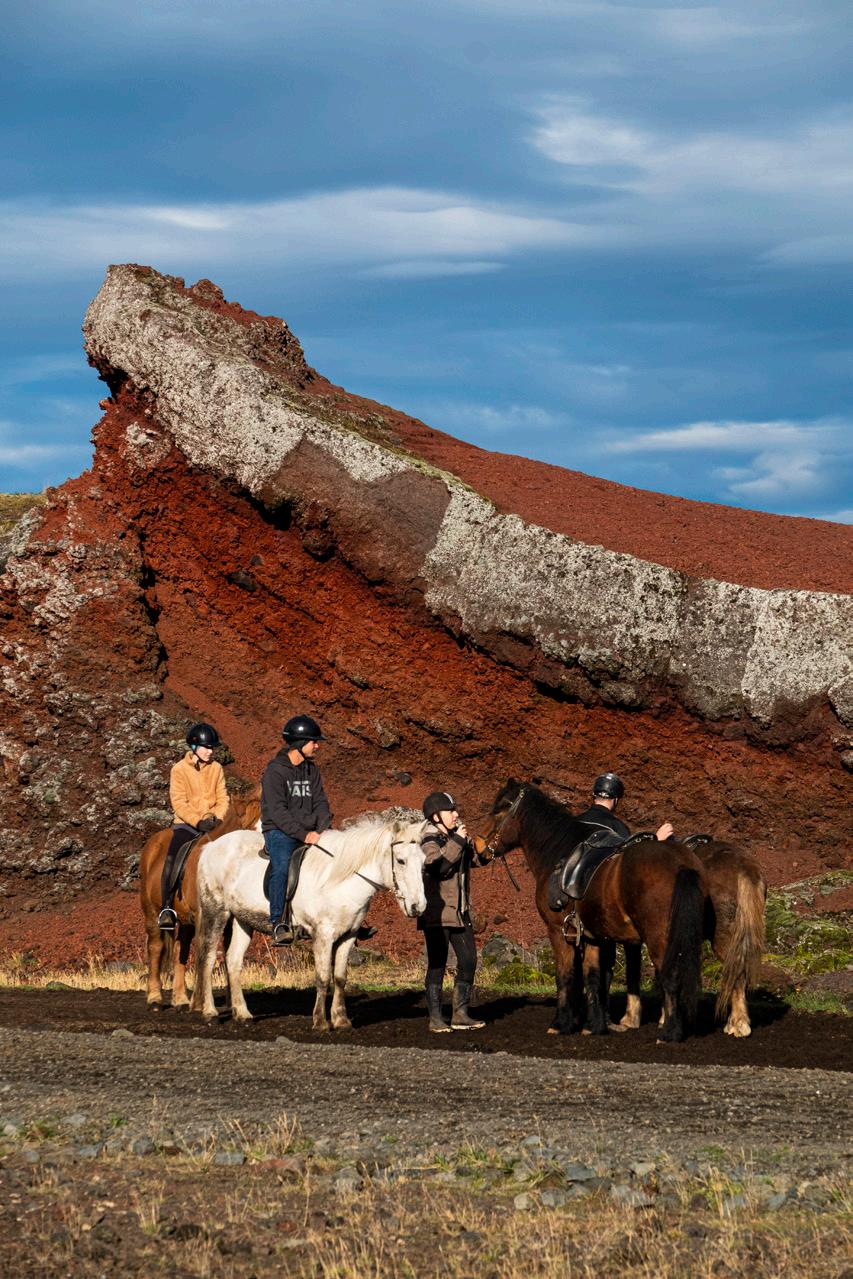
The crème de la crème of Icelandic horses is kept in Iceland to compete domestically or breed.
They’re part of Iceland’s
The Icelandic horse’s forefathers first arrived with Viking settlers from the British Isles between 860 and 935 AD. While they are known ancestors of Shetland, Highland and Connemara ponies, they also have some genetic similarities to the Mongolian horse, which arrived in Scandinavia through Russia.
They can never come home again
No, Icelandic horses do not spend their days reading Thomas Wolfe. Rather, the same restrictions that prevent the import of other breeds from abroad also apply to any Icelandic horse that leaves the island. They can not return to Iceland.
As a result, Icelanders participating in international riding competitions never take their best horse along

Icelandic horses feature heavily throughout the country’s history books. In the Book of Settlement of Iceland, chieftain Sela-Þórir established his settlement at the place where his mare Skálm decided to rest. Meanwhile, in Hrafnkel’s Saga, Njál’s Saga, Grettir’s Saga, and others, horses play important roles in fights, as status symbols, and as plot devices. For example, when the epic hero Gunnar á Hlíðarenda falls to the ground when his horse trips, he looks at his beautiful country and decides to stay rather than be outlawed, which ultimately leads to his death.
In Norse mythology, the most famous equine is, of course, Óðinn’s eight-legged steed Sleipnir. Icelandic horses have the standard four legs, but it can look like eight when they are zipping along at a flying pace.
Possibly the best thing about the Icelandic horse from a visitor’s perspective is that you can ride one just about any time. Riding centres all over the country offer riding tours so visitors can experience Iceland’s uniquely beautiful nature from the back of one of Iceland’s uniquely wonderful horses.
Thanks to their temperament and size, the Icelandic horse is ideal for inexperienced riders taking a shorter tour. Their smooth gaits make them comfortable for more experienced riders looking to spend a whole day in the saddle.










Laxnes Horse Farm is a family owned and operated business with our horses being part of the family and treated as such. We offer a variety of day tours, combo tours and daily private tours. Please visit our site www.laxnes.is for further information and frequently asked questions.


A trek on the hardy, sure-footed Icelandic horse is an experience to remember. Whether you are a beginner or expert, old or young, these friendly horses, with their alert and willing nature are indeed a pleasure to ride in their natural surroundings.

The private tour is a variation of our Laxnes Special tour and will have daily departures by summer 2023. You´ll be able to tailor your tour time to up to two hours and enjoy the farm surroundings at your own pace.
Combine our Laxnes Special tour with a variety of different activities in one booking for a full day of adventure. Puffin or Whale watching or the Golden Circle combinations with our riding tours are just a click away on our site.







ACCESS TO 18 GYMS AND 8 SWIMMING POOLS
World Class o ers bright, spacious, and fully equipped gyms across Iceland. Enjoy a wide variety of classes and access to 8 thermal pools.





16-18 million years BC: The formation of Iceland. Volcanic eruptions formed the landmass known as Iceland.
871 AD: The settlement. Ingólfur Arnarson killed a man in Norway and fled to Iceland.
930 AD: Alþingi (the Icelandic Parliament) was established. It’s the oldest still existing parliamentary institution in the world.
1000 AD: Conversion to Christianity, the discovery of America. Parliament decided everyone would be Christian or at least pretend to be. Leifur “the Lucky” Eiríksson got lost and found America, didn’t like it, and came home.
1262 AD: Iceland submits to Norway. Civil war between powerful clans was finally resolved by forfeiting independence and submitting to Norwegian rule, before winding up under Danish rule
1550 AD: Reformation. A violent conflict between Catholics and Lutherans ended with the beheading of Catholic bishop Jón Arason.
1602 AD: Monopoly (not the fun kind). The king of Denmark decided Icelanders could only trade with particular Danes, resulting in economic stagnation
until the monopoly was abolished in 1786.
The 1750s: The Enlightenment and the birth of Reykjavík. Industrialisation and modernisation started when “Sheriff” Skúli Magnússon started wool manufacturing at Aðalstræti 10.
1944 AD: Independence. Iceland declared independence while Denmark was too busy being invaded by Germany to protest.
1955 AD: Nobel Prize. Halldór Laxness was awarded the Nobel Prize in Literature.
1980 AD: First female president. The world’s first democratically elected female head of state, Vigdís Finnbogadóttir, took office.
2008 AD : Crash and miraculous recovery. Iceland’s banking system went spectacularly bankrupt. Since then, things have picked up surprisingly well.
2009 AD: First openly gay prime minister. The world’s first openly lesbian head of government, Jóhanna Sigurðardóttir, took office.
2010 AD: Volcano. International air traffic was delayed for weeks after the Eyjafjallajökull volcanic eruption.
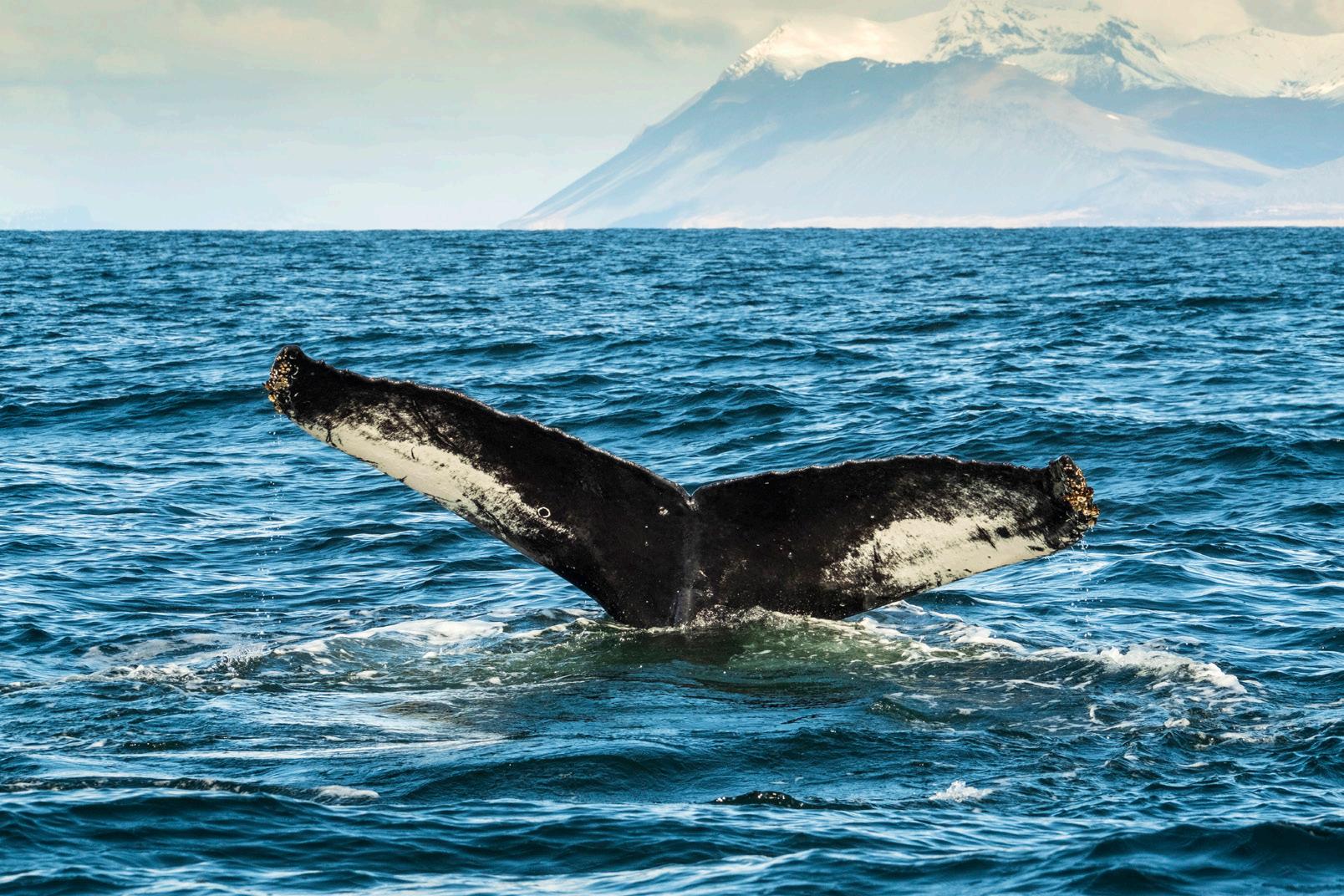
Do you want to have a whale of a time? Then go on a whale safari while you’re in Iceland! The waters around Iceland are the natural habitat of these gentle giants, so this is the perfect place to spot them. Baleen whales are a migratory species, and most travel long distances to tropical waters in winter and back to polar regions in summer. The best season for whale watching in Iceland is, therefore, between April and October. Going on a whale watching tour and actively searching for whales is an exciting and unique experience!
You don’t have to travel far to go on a whale safari, as Reykjavík offers good options for whale watching. Different whale watching companies have regular departures from the Old Harbour area. White-beaked dolphins and harbour porpoises are seen year-round in Faxaflói bay, a large bay next to Reykjavík, stretching from Reykjanes to Snæfellsnes. In the summertime, there are regular sightings of humpback whales and minke whales. You can choose to go on a bigger boat with a refreshment bar, or on a small RIB. The bigger boats have snug inside areas that offer shelter from bad weather, but the small boats have the advantage that you can get very close to oceanic wildlife. At the ticket offices, you can ask for complimentary

motion sickness pills, but don’t worry, tours are cancelled if the waves are too high.
You can also see whales outside of the Capital Area. In wintertime, the fishing town Grundarfjörður is where it’s all at. The bay is filled with herring feeding on phytoplankton. Now, seeing breaching herring is probably not the reason why you travelled to Iceland. However, this herring aggregation attracts all kinds of cetaceans, like dolphins, porpoises, and most importantly, killer whales! Can you think of anything more spectacular than seeing a pack of killer whales swim by? There are also excellent whale watching opportunities in North Iceland. The town Húsavík is also known as the whale watching capital of Iceland, because of the many whales in its bay, Skjálfandi bay. Humpback whales, blue whales, minke whales, pilot whales, and sperm whales are often sighted. Because of the deep waters in the bay, there is also a higher chance of seeing rare species like the basking shark, the northern bottlenose whale, and the beluga!
In summer, puffin colonies are found all around Iceland. The first small flocks arrive in April, and the last ones leave in September, but the best months to see puffins are between May and August. Most whale watching companies offer whale and puffin combination tours. For puffin spotting, it’s best to be on a small boat and to bring binoculars. Puffins are tiny, and the closer you can get to them, the better the experience will be! These puffin tours are possible from Reykjavík. Just off the coast of the city, puffins breed each year on three small islands. Next to puffins and whales, common sights during these tours include arctic terns and the great skua.
Whales of Iceland is an exhibition in the Grandi area of Reykjavík. It showcases 23 man-made life-size models of whale species that occur in Icelandic waters, like a 25m long blue whale and a full-size sperm whale. It offers a great opportunity to see the actual sizes of these whales (they are even bigger than you think!) and to learn interesting facts about each whale at the same time by reading plaques and watching videos. Educational and fun!

Minke whale: a small baleen whale measuring 7m to 8m in length, weighing between 5 to 10 tonnes. It’s black and grey, has a dorsal fin, and will live for 30 to 50 years. It’s not likely to breach, so look for its back and dorsal fin during a tour. Also called “stinky minkes” because they smell of rotten fish.
Humpback whale: a large baleen whale measuring 12m to 16m in length and weighing about 36 tonnes. It has long pectoral fins, a stubby dorsal fin, and a knobbly head. They are known for breaching, their high spouts of water, and for showing off their flukes as they go for deeper dives!
White-beaked dolphin: the most common dolphin in Icelandic waters. It is 2.5m to 3m in length and weighs up to 350kg. They are often spotted in big groups, sometimes hundreds together! They love playing, jumping out of the water, and splashing about.
Book your whale watching tour on WhatsOn.is
Harbour porpoise: the smallest cetacean around Iceland. They are only 1.5m to 2m in length and weigh 55kg to 70kg. They are usually quite shy but sometimes jump out of the water and play with the whale watching boats.


At the time of writing (16 April), the most recent eruption on the Reykjanes peninsula began on April 1 and finished on 3 April. While the string of eruptions that began in Iceland in 2021 first proved to be a largely harmless tourist attraction, the effect on the town of Grindavík has been a reminder to take these forces of nature seriously.
Grindavík was opened to the public again on 21 October after being closed with exceptions for residents and other relevant people for over a year. Visitors still need to exercise caution. Lava that appears dry and cool can still be molten just below the surface.
Many visitors are also curious about the impact on the Blue Lagoon, a geothermal lagoon on the Reykjanes peninsula, and one of Iceland’s mostvisited tourist destinations. Since the beginning of the volcanic unrest on the Reykjanes peninsula, the Blue Lagoon has had to evacuate several times. At the time of writing, the Blue Lagoon is open, but this can of course change at a moment’s notice. We recommend staying up to date and checking your
reservation online before you go. Check for the latest updates here: bluelagoon.com/seismic-activity
Geologists predict the next eruption could occur with very little notice. The rest of Iceland is not affected by these events and is safe to travel. The airport in Keflavík operates normally and flights are unlikely to be affected, even in case of another eruption.
Please keep yourself informed during your travels in Iceland and exercise common sense.
Good resources in English are:
• Daily news: Icelandreview.com
• Official travel warnings: safetravel.is,
• Icelandic Road Administration: road.is,
• The Icelandic Met Office: vedur.is
• Website of the Department of Civil Protection (https://www.almannavarnir.is/english/).
safetravel.is


Reykjavík sightseeing has something for everyone! The city is filled with things to do, places to go, and stuff to see, but some things are just a little bit more important than others.
Check out the map in the centre of the magazine to find the exact location of these Reykjavík sights.

HALLGRÍMSKIRKJA
Hallgrímskirkja church is one of Reykjavík’s most iconic buildings and is visible from almost anywhere in the city. It’s the largest church and the 6th tallest architectural structure in Iceland. The church tower offers a fantastic view of the city. It’s named after the Icelandic poet and clergyman Hallgrímur Petursson, author of the Passion Hymns. The architect, Guðjón Samúelsson, designed it to resemble the basalt lava column flows of Iceland’s landscape. Construction started in 1945 and was finished in 1984.
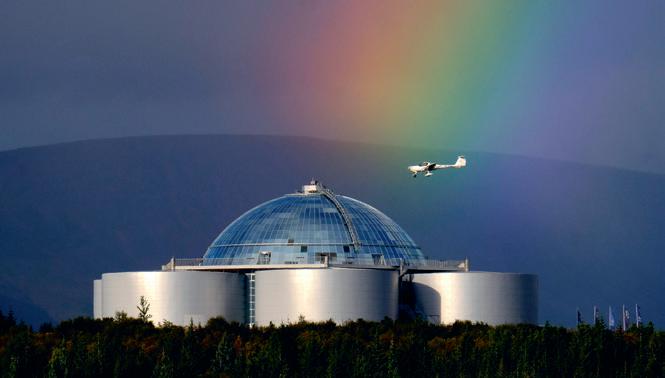

PERLAN Standing at 25m, Perlan is one of Reykjavík’s most striking buildings. Built on top of the city’s hot water tanks, Perlan is known for its unique architecture. Inside Perlan, you can visit Wonders of Iceland, an exhibition spread over multiple levels. A visit to a real ice cave, planetarium shows, exhibitions on Iceland’s history, glaciers, volcanoes, and water, and a spectacular 360° viewing platform are all included in a ticket. On the top floor, there is a restaurant and coffeehouse for guests in need of refreshment. Surrounding Perlan is the Öskjuhlíð area, one of the many green spaces in Reykjavík, perfect for a walk on a sunny day.
TJÖRNIN Tjörnin (The Pond) is the heart of the city centre and offers some of the most amazing views in Reykjavík. There is no better place in the city to enjoy a beautiful sunset, and you can watch or feed a huge variety of birdlife that calls the lake home while you’re at it. When the lake freezes over in winter, geothermal water is pumped in to defrost an area for the birds and feeding them is a popular family pastime all year round. Those who can handle the cold take to the lake on ice skates.

When the sun is shining, Austurvöllur is the place to be. Surrounded by cafés and restaurants, this public square is a popular spot for locals to dine outside, soak up some sunshine or recline on the grass with picnics. In fact, whatever the season, Austurvöllur is the place to be. It’s used for celebrations on holidays, and in December, the city’s biggest Christmas tree is located there. Due to its proximity to The House of Parliament, Austurvöllur is also a popular gathering spot for political protesters. At the centre of it all stands a statue of Jón Sigurðsson, the renowned figure who is credited with leading Iceland to independence.

Just off the city centre lies Reykjavík’s old harbour area. Known as Grandi, the land was originally just a stretch of sand connecting Reykjavík to Örfirisey island but has been added to considerably in the years since. For decades, this was simply an industrial neighbourhood with fish processing plants and shipyards, but when the new harbour by Sundahöfn was built, much of the industry was moved there, leaving empty buildings in a popular area waiting to be repurposed. Now Grandi is full of life, with a food hall, popular ice cream parlour Valdís, Omnom chocolate headquarters, FlyOver Iceland, Lava Show and a lot more.

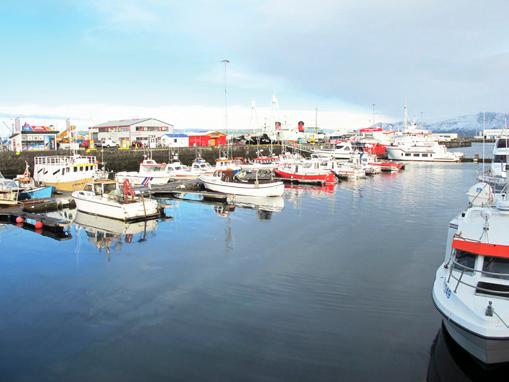
HARPA The whole 28,000m2 of Harpa stand at the edge of Reykjavík Harbour. It houses Iceland’s biggest concert hall, suitable for a broad range of concerts and cultural events, a conference centre with meeting facilities and in-house catering, as well as a couple of fine restaurants. Harpa also hosts promotions, plays, and public events. Harpa was designed by a Danish firm in cooperation with Ólafur Elíasson, an Icelandic artist, and opened to the public in 2011.
THE OLD HARBOUR Though it’s the oldest harbour in its original form, Reykjavík’s Old Harbour is no longer the busiest for freight. Instead, it’s an oft-visited area where you’ll find a community of shops, galleries, electric bike and scooter rentals, and tour operators. You will also find numerous whale watching companies willing to take you out to sea on unforgettable excursions. The area is filled with excellent restaurants (pizza, seafood, burgers, etc.) and cafés. The atmosphere at the old harbour is friendly, the air is fresh and salty, and there are plenty of interesting activities to check out.



THE SUN VOYAGER A beautiful sculpture of a Viking ship located by the ocean on a small peninsula by Sæbraut, close to downtown Reykjavík. The sculpture by Jón Gunnar Árnason symbolises the Viking past of the Icelanders and is an ode to the sun. It serves as a reminder of our history and heritage when the first Viking settlers came sailing to Iceland. The Sun Voyager looks its best when the sun is setting, at whatever time that may be. The unforgettable view of the sculpture with a backdrop of the ocean and Mt. Esja is every photographer’s dream.
OF
Founded in 950 AD, Iceland’s Parliament, Alþingi, is the oldest extant parliament in the world! For centuries, the Parliament gathered in the open air (on the aptly named Þingvellir, Parliament Fields), but in recent years, the members of Parliament have met in Reykjavík. The House of Parliament is a modest classical building of hewn Icelandic dolerite, and it gives Austurvöllur square a dignified look. The Parliament garden behind the building is small but lovely in the summertime.
Every country has traditions when it comes to leisure. Icelanders’ favourite pastime is going swimming. Laugardalslaug is the city’s largest pool with extensive facilities, located in Laugardalur valley. Its facilities include a 50m outdoor pool, an outdoor children’s pool and a paddling pool, two waterslides, numerous hot tubs, a steam bath, gym, and a mini-golf course. There really is no better place to be on a sunny day or a cold one for that matter. Right outside, you will find a hot dog stand where you can buy traditional Icelandic hot dogs.



The Reykjavík Art Museum has three locations: Hafnarhús, Kjarvalsstaðir and Ásmundarsafn. Hafnarhús serves as the museum’s branch of contemporary art, through rotating exhibitions. Kjarvalsstaðir is devoted to one of Iceland’s most influential painters, Jóhannes Sveinsson Kjarval. Ásmundarsafn is the former home and workshop of sculptor Ásmundur Sveinsson.

In 2001, archaeological remains of the settlementera hall were excavated, which was inhabited from 930-1000. North of the hall, two pieces of a turf wall were found, which were built before 871. These findings are the oldest relics of human habitation found in Reykjavík.

art collection that mainly comprises 19th- and 20th century artworks. The Gallery possesses many of the keystones of Icelandic art history, as well as a growing collection of works from other countries.

The nation’s most precious treasures are kept and displayed at the National Museum of Iceland. The museum was established in 1863, and gives an insight into Iceland’s cultural heritage from the time of settlement up to modern times.
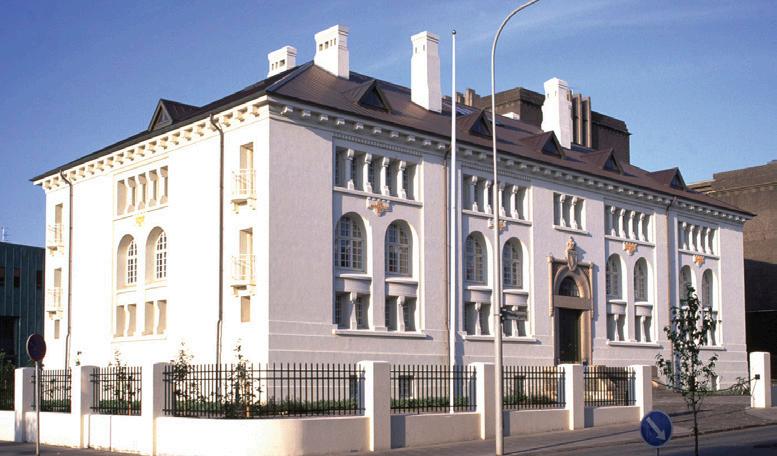
The exhibition Treasures of a Nation in the House of Collections throws light on the invaluable collections of the National Gallery of Iceland; the art reflects the zeitgeist of each era, for art is in constant dialogue and renewal, in step with society itself.

dedicated to the work of Einar Jónsson Iceland’s first modern sculptor (1874-1954) who offered all of his works as a gift to the Icelandic nation.


Jómfrúin stands for quality tradition that is worthy of preservation. Lækjargata 4 | +354 551 0100 | jomfruin.is DANISH THE ICELANDIC WAY
Jómfruin is proud to carefully combine superb Icelandic ingredients with age-old Danish heritage so that guests can enjoy a culinary experience like no other.


An extraordinary amount of books are published in Iceland each year, considering the size of the nation. The Christmas season is the most important period in publishing in Iceland because books are a particularly popular Christmas gift. The majority of books are sold in December and for a few weeks around Christmas, every Icelander is a literary critic! It’s known as the Christmas book flood, so take a dive!
THE SAGAS OF THE ICELANDERS
BY AUTHORS UNKNOWN
You can get a collection with all the sagas, but we recommend starting with the most popular ones, such as the epic Njáls Saga, the adventurous Egill’s Saga, or the romantic Laxdæla Saga. Reading these centuries-old texts is challenging but rewarding at the same time.

BY HALLDÓR LAXNESS

Independent People is Halldór’s best-known novel and it is nothing short of a masterpiece, but it’s also a bleak and depressing portrait of a poor farmer’s life complete with domestic violence, class injustice, child labour, and light paedophilia. What we’re saying is that this is no fun summer read. If you think you’re up for it, by all means, go ahead, but for a more palatable taste of Laxness, we recommend picking up The Fish Can Sing, a charming coming-of-age story set in Reykjavík at the turn of the century.
BY EINAR KÁRASON
Devil’s Island by Einar Kárason tells the story of life in Iceland after World War II, when families were living in barracks left by the US army. The rural community
in Iceland conflicted with American pop culture brought to the country by American troops during the war. The story revolves around one family and reads just like an Icelandic saga. The movie adaption of the book by director Friðrik Þór Friðriksson was released in 1996.
BY ANDRI SNÆR MAGNASON
Among Andri’s oeuvre is a book of discount poetry sold in grocery stores, children’s books, and a nonfiction books on the state of Iceland’s industry and its future direction. He also ran for president of Iceland in 2016 and came in third.


LoveStar is a dystopian novel, initially published in 2002, set in a future where a giant corporation controls the lives of people through their personal
data, love is controlled by algorithms matching people to their mates, and people can making a living as influencers by secretly advertising products through their lifestyle. Frightening, isn’t it? An unconventional love story set among Iceland’s stunning landscapes.
BY YRSA SIGURÐARDÓTTIR

Yrsa is the queen of Icelandic crime fiction. Despite writing about horrific crimes in a country with statistically less than one murder per year, Yrsa is knwown for writing believable and threedimensional characters as well as a thrilling plot with twists and turns aplenty. Her books about Þóra Guðmundsdóttir, a crime-solving lawyer, are immensely popular, but she’s also written a few more thrilling stories stretching into the realm of ghost stories and the supernatural. I Remember You combines an eerie ghost story with crime fiction and was made into a movie in 2017.


"EastWest provides exceptional small group tours and private tours so you can enjoy the famous Golden Circle, the dramatic landscapes of the South coast, the breathtaking peninsula of Snæfellsnes, or the incredible Northern lights. Our driver-guides deliver travel experiences of the highest quality in a prime fleet of Mercedes-Benz Sprinters with USB connectors and onboard WIFI."

Children (0–15* years) Free Young people (16-17 years)* 210 kr.
Adults (18 years and older) 1380 kr.
Thermal pools and baths in Reykjavik are a source of health, relaxation and pureness. All of the city´s swimming pools have several hot tubs with temperatures ranging from 37˚ to 42˚C (98˚–111˚F).
The pools are kept at an average temperature of 29˚ C (84˚ F)


Whether you visit a thermal pool in Reykjavík, a luxurious spa, or a natural pool in the countryside, swimming in Iceland is a unique experience. Nothing beats relaxing in warm water while breathing in fresh cold air.

Vesturbæjarlaug
Swimming pools are one of the most kid-friendly activities you can find in Iceland, so the short answer is – all of them! To be more specific, the centrally located Sundhöll has a great outdoor area, and so does Vesturbæjarlaug, but Árbæjarlaug is a hidden gem, a perfect stop if you’re going out of town anyway, and pairs well with a visit to the Árbær Open Air Museum.
Locals love going to the pool, and chilling in a hot tub is a good way to connect to Icelanders. Often, Icelanders meet in the pool and use this time to chat and catch up on the latest developments. Good options for hanging out with locals are Vesturbæjarlaug, Seltjarnarneslaug, and Árbæjarlaug pools.
Laugardalslaug is Reykjavík’s biggest pool and the best one for a long swim. It’s an Olympic-size swimming pool, used for recreational swimming,

Laugardalslaug
exercise, and competitions. The big indoor pool is also used for training and competitions. Laugardalslaug also offers plenty of hot tubs, cold tubs, and steam baths for relaxation after a healthy swim, and to top it off, a fitness centre and spa are located next to the pool.
Basically every town in Iceland has its own pool. Almost all of them are beautifully located next to mountains and overlooking fjords and the ocean. If you plan to make a day tour out of your pool visit, head to the Westman Islands and visit Sundhöllin Vestmannaeyjar on Heimaey island. The ferry ride out to the island is an adventure, and there is a great indoor pool, a large outside pool with hot tubs, and cool waterslides.
In need of pampering? You’ve heard of the Blue Lagoon with its milky blue waters and mud masks, but did you know a brand-new spa opened just 10 minutes by car from downtown Reykjavík? Located at the edge of the bay of Kópavogur, the pool offers amazing coastal views. Sky Lagoon boasts a modern approach to traditional Icelandic swimming culture, making it the perfect spot to relax, enjoy a drink, socialise, and soak in the sun.
WINTER OPENING HOURS
More info on www.sundlaugar.is
Árbæjarlaug (Tel. 411 4200)
Mon - Fri: 6:30-22 • Sat - Sun: 9-22
Dalslaug (Tel. 411 5650)
Mon - Fri: 6:30-22 • Sat - Sun: 9-22
Grafarvogslaug (Tel. 510 4600)
Mon - Fri: 6:30-22 • Sat - Sun: 9-22
Laugardalslaug (Tel. 411 5100) Mon - Thu: 6:30-22 • Fri - Sun: 8-22
Vesturbæjarlaug (Tel. 411 4200)
Mon - Fri: 6:30-22 • Sat - Sun: 9-22
Breiðholtslaug (Tel. 557 5547)
Mon - Fri: 6:30-22 • Sat - Sun: 9-22
Klébergslaug (Tel. 566 6879)
Mon - Thu: 11-22 • Fri: 11-19 • Sat - Sun: 11-18
Sundhöllin (Tel. 411 5350)
Mon - Fri: 6:30-22 • Sat - Sun: 8-22








By The Old Harbour







Hot springs, saunas, plunge pools, and steam rooms have been part of Icelandic culture for centuries. If you’re hiking, there’s no better way to soothe tired muscles and achy joints than a relaxing soak. But where to soak?

Krauma is a natural geothermal spa next to Deildartunguhver, Europe’s most powerful hot spring. It’s located in West Iceland, in the valley of Reykholtsdalur, a 1.5h drive from Reykjavík. Krauma has five hot tubs, one cold bath, a relaxation room, and two steam baths. The perfect water temperature is reached by mixing glacial water with water from the hot spring. When you’re in the pool, you can order drinks that are brought to you straight in the hot tubs. If you’re longing for a bite to eat after bathing, there’s also a restaurant. Krauma is open every day 11 AM – 9 PM.
Just fifteen minutes from downtown Reykjavík, the Sky Lagoon was constructed in an impressive 15 months during the pandemic. The vibe is stylishly luxurious and expensive, and as the only bathing lagoon within the city limits, it’s the one that’s easiest to access. A traditional herringbone turf
facade gives way to Bond villain aesthetic within and a great sea view from the sauna through the biggest window in all of Iceland. ‘Norse bathing culture fused with modern Nordic design’ says Vogue. The spa’s experience is built around a seven-step ritual after which there’s a cafe, bar and restaurant should the spirit move you. Booking in advance is advised.
The wildly popular and photogenic Blue Lagoon is located 50 minutes west of Reykjavík and 20 minutes from Keflavik airport. It all started in 1981 when people started bathing in the curious turquoise-coloured run-off pools of the Svartsengi geothermal power station. The Blue Lagoon is located on an 800-year-old lava field on the Reykjanes Peninsula and is so popular reservations are required. The water, a combination of fresh and seawater from the nearby geothermal plant, is about 98 degrees, slightly cooler than your average hot tub. There are grottoes, steam rooms and an on-site restaurant, so spending at least a half-day at the lagoon is recommended. If you are travelling with your family, you can easily spend a full day at the Blue Lagoon with your kids. Note: operations at the Blue Lagoon have been affected by the recent volcanic activity in the area. At the time of writing, the Blue Lagoon is open, but it never hurts to double-check the Blue Lagoon website!
Hvammsvík is a family-owned estate consisting of 1200 acres of land, situated in the middle of Hvalfjörður, a historic fjord in the southwest of Iceland. The bathing spot is right on the water, with rustic pools overlooking the surrounding farmland and the sea. Mentioned in the Book of Settlements as an early settlement, it also became an important location during the Second World War when the Allies occupied Iceland. Hvammsvík is only a 45-minute drive from Reykjavík city centre and an easy drive to many of Iceland‘s biggest attractions, such as the Golden Circle, Glymur, Þingvellir, Esjan, and many more. The spa offers 8 geothermal pools built by the sea, and tough ones can prepare for a cooling polar plunge in the ocean! They are open 10:30 AM – 8:30 PM year-round. You will also find a bistro and accommodation, and there is a direct bus transfer that can take you from Reykjvík to Hvammsvík. It is recommended to book your tickets in advance!
Located in the middle of the Golden Circle,

Laugarvatn Fontana Geothermal Baths offers several hot pools, a steam room, and more. Locals have been enjoying the healing power of the natural steam baths by Lake Laugarvatn since 1921. You will find three pools – Lauga, Sæla, and Viska – that are connected to outdoor mineral baths that vary in temperature, depth, and size. Around the pools is the playful stone artwork by Icelandic artist Erla Þórarinsdóttir. Fontana also has an authentic, Finnish-style sauna, perfect for relaxing after a long day of hiking and sightseeing. For a truly Icelandic experience, you can move between the hot pools and the icy waters of Lake Laugarvatn, as the cold temperature is believed to have beneficial health effects. Next to the spa, there is a geothermal bakery where they bake their bread using the natural heat from the earth! Laugarvatn Fontana is open every day year-round, 11 AM – 9 PM in winter (October to May) and 10 AM – 9 PM in summer (June to September).
Created in 1891, Secret Lagoon – known in Icelandic as Gamla Laugin (the old pool) – is one of the oldest swimming pools in Iceland. It was abandoned for years but was renovated and reopened in 2014 with brand-new showers and changing rooms. The pool is a comfortable 38-40 °C (100-104 F) and may not be as much of a secret as it once was. Located next to a spouting geyser, the Secret Lagoon is a much quieter, simpler (and cheaper) alternative to the Blue and other spa-style lagoons. Nearby is a geyser, bistro, and a beautiful geothermal area. From October to May, the Secret Lagoon is typically open 10 AM – 7 PM, but it will be closed May 13 – 23 for renovations.


If you‘re staying in Reykjavík for any period of time, you might want to get acquainted with the public transportation system, STRÆTÓ.
We don’t have trains or an underground system, only our beautiful yellow public buses. They‘ll take you nearly anywhere you need to go, but you might require some help to navigate the system. If you’re looking for some tips to make your life easier on the streets of Reykjavík, here’s how to take the bus in Reykjavík.
As of this writing, a single adult ticket costs ISK 670. Children 11 years and younger are free, the disabled pay 200 ISK, and seniors and children 12-17 pay 335 ISK.
You can buy a ticket on the bus, with a touchless card payment or with the exact amount in cash (the drivers do not have change). Paper tickets used to be available at local stores and swimming pools, but Strætó has discontinued these as of March 2022.
You can pay for your fare through the awardwinning app, Klapp. Using only your smartphone, you can pay for one-time fares for individual rides, purchase Klapp 10 (10 tickets), or buy a one-month or a one-year pass. It should be noted that you will need to use data or WiFi to make this transaction and use it on the bus.
Like the city buses, the regional buses accept card payments. You can also pay by cash, but again, only if you have the exact amount. Prices vary depending on your destination.
If you are staying in or travelling to the countryside via Strætó, the Klapp app will not work. For trips in the countryside, you can pay with debit or credit cards on the bus, bus cards or with cash (note again: drivers cannot give change).
The timetables can be found on the Strætó website,
and each bus stop has the departure times for the buses that stop there. The Klapp app also has the departure times and will calculate your route for you. Generally, the buses start running before 7 am on weekdays (slightly later on weekends, but still before 10 am) and run until around midnight, depending on routes.
When deciding which bus to take, get the route number and the terminus. While you are waiting for the bus, check to make sure you’re waiting on the right side of the street. On a little sign right next to the bus stop you’ll find the timetable for your route. Above the timetable, you will find the names of the bus stops on the way (the one you are on is specially marked) with the terminus at the end of the line. Make sure it matches the one you are supposed to take.
If it does not, cross the street. When the bus arrives it will also be clearly marked with the route number and the terminus. Occasionally, the bus drivers forget to change it at the end of the line, so just in case, it does not hurt to ask the driver. They can also help you figure out when to step off the bus.
ticket for 75 minutes. If you paid by cash, just ask for a “transfer ticket” when you enter the bus. The ticket is valid for 75 minutes, and you can show it to the bus driver when you enter the next bus. If using the Klapp app, you will also have 75 minutes to use your ticket. Simply scan the same ticket on the bus you are getting on, and it will work exactly

If you need to change routes or get on a different bus for the full journey, you can reuse your Klappið
Travelers should note that Hlemmur, Reykjavík’s central bus station, is closed for construction. Stay up to date with the latest route changes and more at straeto.is
• Buy tickets
• Plan your trip
• Bus location in real time



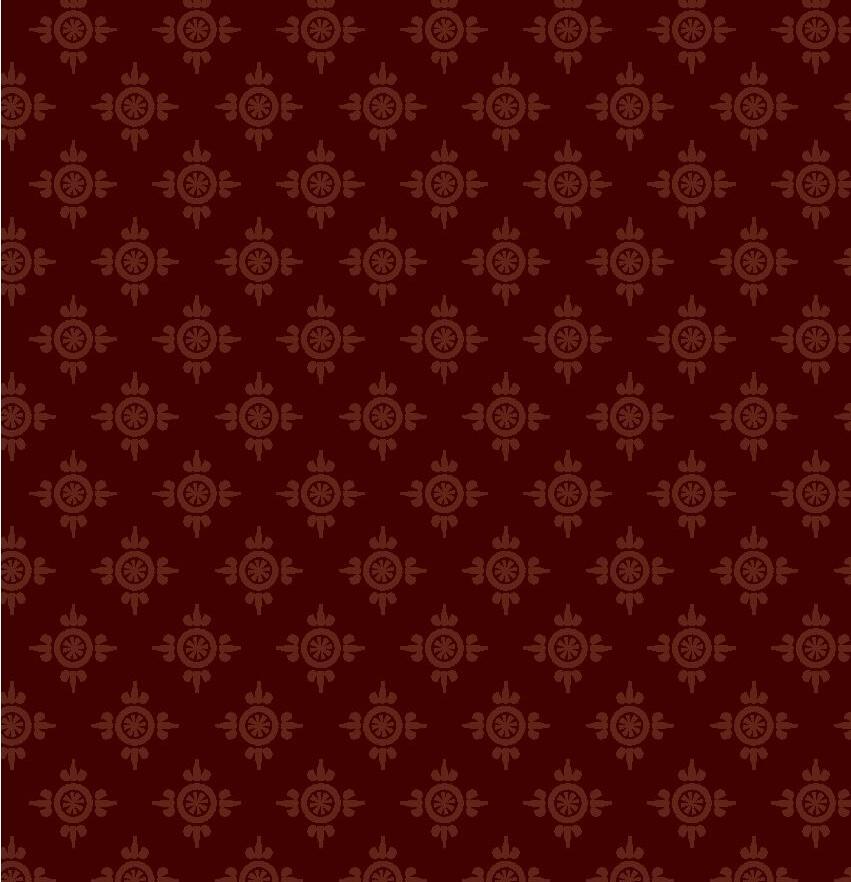





Elliði
Rafstöðvarvegur 10
A new café has opened where Á Bistro used to be located in the valley of Elliðaárdalur, next to the old power plant. Opening hours are from 11 to 17 and the menu offers light lunch courses, coffee, cakes, avocado toast and more. The café is well accessible by foot, public transport, and driving. If people choose to go for a beer, a direct bus goes from there to Lækjartorg downtown. It is also a great place to take children due to the natural surroundings and playground in the area.
Emil & Lína
Laugavegur 53b
Emil & Lína is a new children’s clothing store on Laugavegur. The designs are inspired by Iceland’s viking heritage and the woolen sweater (lopapeysa). The brand Emil & Lína first appeared as a Facebook page with second hand children’s clothing for sale. They also derive inspiration from Iceland’s countryside, adventures and folk tales. A special feature of these woolen sweaters is that the wool does not sting/ itch, making it ideal for the youngest generation.
Indian Bites
Kringlan 4-12
A new Indian restaurant has opened in the food hall in Kringlan shopping mall, offering classic and new Indian dishes from the Pune region. They offer vegan and lactose free options. Their tasting menu is a great way to sample their most popular dishes, e.g. three ready made courses with lamb, chicken or veggies and a samosa
Bryggjuhúsið
Vesturgata 2
A new restaurant in the wooden house where the historic Kaffi Reykjavík used to be located. The house was built in 1863 but has not been in use for the past few years. Besides the new restaurant, it will have a cheese store, a champagne and sandwich loaf bar, and a “wine palace” where people can go for tastings and introductions.



MAY 1-3 • IÐNÓ
The festival returns to mark 15 years from its initial version, based on an international model where the joy of playing is at the forefront with acoustic performances. Besides the main program in IÐNÓ, there are off-venue concerts at RVK Brewing Company in Tónabíó from May 1-3.
Tickets available on tix.is

MAY 9 • IÐNÓ
Unnar Gísli Sigurmundsson started strumming an old and worn out guitar in Westman Islands in his twenties and quickly found his calling. Júníus Meyvant became his artist name and he released his first song, Color Decay, in 2014, that caught attention around the world. Since then he has continued to catch minds and souls internationally with songs like Signals, Gold Laces and Ain’t Gonna Let You Down. He has now released three LPs and two EPs. Bear the Ant are known for their dreamy tones and melodies. Tickets available on tix.is

MAY 12-16 • VARIOUS LOCATIONS
Iceland Innovation Week is a festival that celebrates and showcases innovation in May every year. Events ranging from panel discussions and company visits to happy hours and an icy ocean dip are held in locations in Reykjavík throughout the week. That means that founders, startups, larger companies, and public institutions participate. The festival aims to increase the innovation sector’s visibility, create a platform where knowledge can be shared, and become a vibrant, international marketing window.
MAY 3 AND 24 • SUNDHÖLL HAFNARFJARÐAR
Haven’t you always wanted to experience the swimming pool as a theater? Well, now is your chance! Hafnafjörður swimming hall becomes a theater. The relationship between body and water is explored in a seductive performance that juggles between contemporary dance and theater. An ode to the physical body; wrinkles, orange skin, goosebumps, soft and hard lines, thin and thick skin. Creators and performers Snædís Lilja Ingadóttir and Sigríður Ásta Olgeirsdóttir are joined by Katla women’s choir here. Tickets available on tix.is
MAY 22 AND 23 • HARPA, ELDBORG

Kristján Kristjánsson, better known as KK, has long been one of the most beloved musicians in Iceland. KK made a powerful entrance into the Icelandic music scene with his album Bein leið, released in 1992, which included hits like Vegbúinn and Þjóðvegur 66 (e. Road 66). At this concert, KK and the Iceland Symphony Orchestra will perform many of his most well-known songs in new orchestral arrangements with guests. The songs span his long and successful career, including hits such as Álfablokkin, Grand Hotel, and I Think of Angels.

MAY 24 • HARPA, ELDBORG
Re-live the magic of country music’s most iconic supergroup in a tribute concert honoring The Highwaymen. This one-night-only performance will take concertgoers on a musical journey through the unforgettable sounds of Johnny Cash, Willie Nelson, Waylon Jennings, and Kris Kristofferson. Now, a talented ensemble of Icelandic musicians is coming together to recreate the magic of The Highwaymen in a show that celebrates the group’s timeless hits, including “Highwayman,” “Folsom Prison Blues,” “On the Road Again,” and “Me and Bobby McGee.”
Tickets available on tix.is


SIGURJÓN ÓLAFSSON MUSEUM
INTERLACED
Helga Pálína Bryn jólfs dóttir
The artist Helga Pálína Brynjólfsdóttir works in many dif ferent materials, in cluding Icelandic palagonite, wood, textiles, pap er and silk. The works on this exhibition were shown at Appart_323 in Paris last year, but here they are set up to interact with some of Sigurjón Ólafsson’s sculptures which Helga Pálína has selected.
Laugarnestangi 70 • 105 Reykjavík
Tel: 553 2906
REYKJAVIK ART MUSEUM ÁSMUNDARSAFN
Wonderland - Ásmundur
Sveinsson
Ásmundur Sveinsson (1893–1982) was one of the pioneers of Icelandic sculpture. Going back in time and into Ásmundur’s studio, the exhibition displays Ásmundur’s
the scenes in the artist’s search for the appropriate completion for the ideas that emerged.
Sigtún • 105 Reykjavík
Tel: 411 6430
Catch the Aurora Borealis
All Year Round
There is perhaps nothing more magical than witnessing the beauty of a northern lights display. However, those unpredictable, ever dancing lights don’t always show up on cue – and fade away during the summer months. So, it is with great joy that we welcome Aurora Reykjavík – The Northern Lights Centre, where the northern lights are always on display. Aurora Reykjavík’s pull and ace up its sleeve is its fantastic 4k time-lapse film of the Aurora Borealis.
Aurora Reykjavík’s latest additions are virtual reality goggles featuring the world’s first 360° movie of aurora displays entirely shot in Iceland. If you can’t catch the northern

Capturing the northern lights with your own camera can be challenging, but at Aurora Reykjavík, you receive instruction by the experts: bring your camera and try the right settings at the Northern Lights Photo Simulator. In the exhibition, you will find an entertaining selfie booth – have fun looking all fabulous under the northern lights!
For more information, see www.aurorareykjavik.is.
Fiskislóð 53 • 101 Reykjavík
Tel: 780 4500
GERÐUR permanent exhibition
Gerður Helgadóttir (1928-1975) was a pioneering Icelandic sculptor known for her avant-garde and experimental approach to three-dimensional abstract art. Gerðarsafn, founded in her honour, hosts a permanent exhibition showcasing her prolific creativity and use of diverse materials. This exhibition highlights the complexity and innovation of her work, reflecting her wide-ranging interests. With a collection of fifteen hundred works, Gerðarsafn – Kópavogur Art Museum is the only museum in Iceland dedicated to a female artist, celebrating Gerður’s significant contributions to art.
Guðrún Bergsdóttir
Bergsdóttir developed a unique style in her embroidery works which relate to both craft traditions and geometric abstract art and appeal to people in countless ways. A survey exhibition featuring Bergsdóttir’s works opened at Gerðarsafn on April 30, 2025, curated by Hildigunnur Birgisdóttir. A book about the artist’s career and works will be published by her family parallel to the exhibition. Hamraborg 4 • 200 Kópavogur
Tel: 441 7600
Christian Marclay, The Clock
Begins May 5th
The National Gallery of Iceland is pleased to host the Icelandic premiere of the renowned Swiss American artist Christian Marclay’s masterwork, The Clock, 2010, an epic, 24-hour single channel video with sound. Winner of the Golden Lion Award at the 2011 Venice Biennale and widely acclaimed as one of the most significant works of art of the 21st century, The Clock is both a profound meditation about time and an homage to the history of cinema.
Kristján H. Magnússon
Begins May 24th
Kristján Helgi Magnússon’s paintings made a great impression when he made his entrance onto the art scene nearly 100 years ago. He held exhbitions in cities on both sides of the Atlantic, where critics praised his landscapes, portraits and still lifes. In Iceland, on the other hand, the response to his art was mixed, and today few people are familiar with his work. In a forthcoming retrospective, the National Gallery of Iceland will showcase the works of this short-lived artist, who died in 1938 aged only 34.
Intimacies of the Everyday
Ends May 4th
The National Gallery of Iceland announces a forthcoming group exhibition entitled Intimacies of the Everyday, featuring more than 60 photographs by renowned international contemporary artists, including Agnieszka Sosnowska, Joakim Eskildsen, Niall McDiarmid, Orri Jónsson, and Sally Mann. The works in Intimacies of the Everyday were selected from discrete series within each artist’s practice and represent decadeslong and ongoing preoccupations
with photographing the people and places closest to home.
That’s a Very Large NumberA Commerzbau Hildigunnur Birgisdóttir
The National Gallery of Iceland is pleased to present Hildigunnur Birgisdóttir’s highly-acclaimed That’s a Very Large Number — A Commerzbau, commissioned for the Icelandic Pavilion at the 60th International Art Exhibition – La Biennale di Venezia 2024. The sitespecific installation of sculptural works will be reconceived for the National Gallery, responding to the architectural conditions of the museum, which overlooks Tjörnin and the City of Reykjavík.
The Mystery of the Lumpfish and Other Stories of Fakes and Forgeries
This exhibition examines fakes and forgeries that have come to light based on recent research. It traces how experts in the museum field authentic objects in the collections that are under their care – a process that requires expertise in conservation science, art history, and connoisseurship.
Fríkirkjuvegur 7 • 101 Reykjavík
Tel: 515 9600
Stay and Turn to Stone!
Folklore in Icelandic Art Ends May 11th
The National Gallery of Iceland has many treasures that offer invaluable insight into the visual cultural heritage of the people in Iceland. The depiction of folklore and folktales has been a source of inspiration for Icelandic artists from the beginning of the 20th century to the present day. In Europe, Folktales were first set down recorded in writing in the 19th century, starting with the

Kristján H. Magnússon
Brothers Grimm in Germany. In Iceland, folktales were collected by Jón Árnason, who published a two-volume collection of Icelandic Folk- and Fairytales in 1862-64. The books became hugely popular. The stories even provided inspiration in the Icelandic campaign for selfdetermination in the latter half of the 19th century and contributed to the Icelanders’ growing sense of a national folk culture.
“Resistance” is an interdisciplinary exhibition at the National Gallery of Iceland, catering to all ages and merging visual arts with science. The showcased works explore resistance in both a general and physical context, symbolising opposition to consumption and essential action against climate change. Centred on the sustainability discourse, the artworks prompt contemplation of ethical issues surrounding efforts to enhance sustainability. Different themes, such as land, air, ocean, principles and play can be explored by the visitors. The exhibition invites viewers to reflect on existence, nature, and personal choices, emphasising the reciprocal effects that contribute to a more sustainable life.
Kristján H. Magnússon
Begins May 24th
The House of Collections
Kristján Helgi Magnússon trained as a commercial artist during his advanced studies at the National




• Grilled lamb prime
• Icelandic cod
• Best monkfish in town
• 37 Wines by the glass


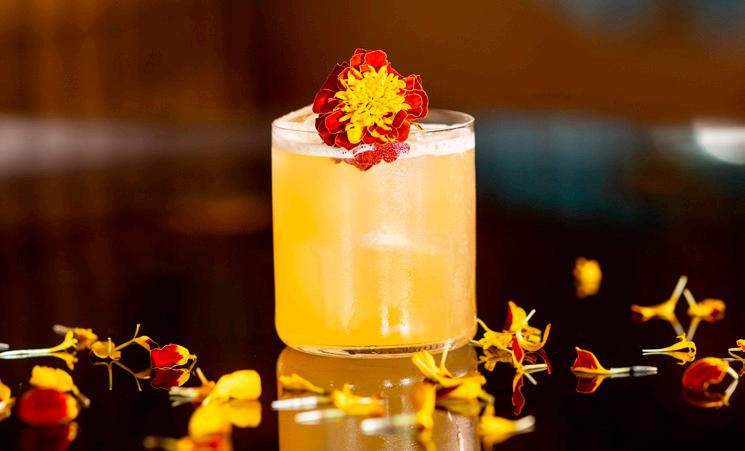


Academy of Design in New York. Kristján’s experience in lithography and advertising design stood him in good stead when he designed advertisements and posters for Eimskipafélag Íslands (the Iceland Steamship Company). Art Deco influence is evident in Kristján’s posters, which will be displayed at the House of Collections on Hverfisgata at the same time as his paintings and drawings are on exhibition at the National Gallery of Iceland. Hverfisgata 15 • 101 Reykjavík Tel: 515 9600
Kjar val: In the land of dreams, magic and faith
Begins May 24th
The exhibition focuses on Kjarval’s fantasy works, emphasizing pieces that include religious themes, divine or enigmatic beings, symbols, and mystical references. It also highlights two major influences on Kjarval’s career: the sculptor Einar Jónsson (1874–1954) and the English poet and artist William Blake (1757–1827). Einar was known for his mythological and religious imagery, emphasizing symbolic meanings, both in sculpture and in paintings.
Kjarval and the 20th Century: When Modernity Anchored
This exhibition showcases artworks by numerous Icelandic artists and Iceland’s most influential painter Jóhannes S. Kjarval, over the span of sixty years after the turn of the 20th century. During Kjarval’s lifetime, enormous changes shaped the Icelandic society, orchestrated by industrialization and travels abroad. Icelandic artists returned from Europe with fresh ideas in their minds, inspired for a shift in their artistic styles. When Modernity anchored depicts that paradigm shift in breaking away
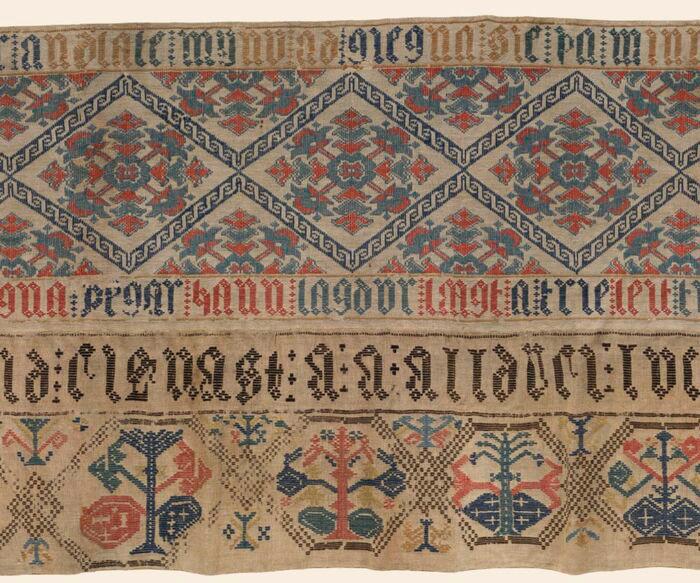
from naturalistic imagery to a more symbolism-oriented artstyle.
Ends May 11th
Women’s Initiative in Icelandic Art in the Eighties is a group exhibition that explores the pivotal role of women artists in shaping the Icelandic art scene leading up to and during the transformative decade of the 1980s. This exhibition is the culmination of a year-long research project dedicated to revealing the intricate networks, resilient connections, and bold initiatives that characterised this era of artistic creation, innovation and exploration.
Flókagata 24 • 105 Reykjavík Tel: 411 6420
The Making of a Nation Heritage and History in Iceland
The National Museum of Iceland’s permanent exhibition, Making of a Nation – Heritage and History in Iceland, is intended to provide insight into the history of the Icelandic nation from the settlement to the present day. The aim is to cast light on the Icelanders’ past by placing the cultural heritage preserved by the National Museum in a historical
context, guided by the question: what makes a nation? The exhibition includes about 2,000 objects dating from the Settlement Age to the present, as well as about 1,000 photographs from the 20th century. The exhibition is conceived as a journey through time: it begins with the ship in which mediaeval settlers crossed the ocean to their new home, and it ends in a modern airport, the Icelanders’ gateway to the world.
Dialogue With Sigfús. Photos from Sigfús Eymundsson and Einar Falur Ingólfsson
Einar Falur Ingólfsson has a visual dialogue with Sigfús Eymundsson (1837-1911). Einar Falur has written about Sigfús’s photos and covered them when teaching history of photography. Sigfús’s photos have acted as a guide on Einar’s travels in Iceland for the past four years, both using the same angles as Sigfús and different angles in the same locations.
To mark Iceland’s 80th Republic anniversary, the National Museum collaborates with Þingvellir National Park, showcasing valences from the late 18th century Lögrétta (Court of Legislature). Originally at
Þingvellir, sold to Robert Mackay Smith in 1858, they now belong to National Museum Scotland. These wool and linen bed canopies feature embroidered decorations and texts, including an adage and part of Hallgrímur Pétursson’s Passion Hymns. On loan from National Museums Scotland, the exhibition will run for a year.
The National Museum of Iceland and the National Film Archive of Iceland collaborate on an exhibition commemorating the events of May and June 1944, leading to the establishment of the Republic of Iceland on June 17th. Unveiling previously unseen footage from the Film Archives, the exhibit will feature photographs, objects, and personal accounts from the National Museum’s collections. It aims to portray the public’s involvement and experiences during this pivotal period in Icelandic history, marked by significant political developments and active citizen participation.
Suðurgata 41 • 102 Reykjavík Tel: 530 2200
The Settlement Exhibition
An open excavation where Viking ruins meet multimedia technology. Just below ground in downtown Reykjavík, this open excavation uncovers the city’s Viking Age history. Discovered during building work in 2001, these archaeological remains turned out to be the earliest evidence of human settlement in the city, with some dating to before AD 872. Careful excavation revealed a 10th-century hall or longhouse, which is now preserved in its original location as the focal point of the exhibition. Interactive technology immerses you in the world of the Reykjavík farm at the time of the first settlers, including information on how Viking Age buildings were

constructed and what life was like in the hall. The Settlement Exhibition is part of Reykjavík City Museum.
Reykjavík
...The Story Continues Family-friendly and informative exhibition about the development of Reykjavík, from farm to city. This new display is a direct continuation of The Settlement Exhibition, representing Reykjavík’s history from settlement to the present day. Visitors get an insight into the complex history and culture of Reykjavík through the development of house construction and planning with a stop at the oldest house in the city centre, Aðalstræti 10. The admission is valid to both Aðalstræti 10 and The Settlement Exhibition in Aðalstræti 16.
Aðalstræti 16 • 101 Reykjavík
Tel: 411 6370
Árbær was an established farm well into the 20th century, and the museum opened there in 1957.
Árbær is now an open-air museum with more than 20 buildings which form a town square, a village and a farm. Most of the buildings have been relocated from central
Reykjavik.Árbær Open Air Museum tries to give a sense of the architecture and way of life and lifestyles of the past in Reykjavík and during summer visitors can see domestic animals. There are many exhibitions and events held at the Museum, which highlight specific periods in Reykjavik’s history. These include craft days, vintage car displays, Christmas exhibitions and much more. There is something for everyone at Árbær Open Air Museum.
Consumption - Reykjavík in the 20th century
The exhibition aims to show the huge and rapid changes that took place in consumption patterns in Reykjavík during the 20th century –to explore the factors that affected consumption, and how technical advances, government actions, wars, and events in Iceland and abroad influenced the daily life of the people of Reykjavík.
Kistuhylur 4 • 110 Reykjavík
Tel: 411 6320
This is a museum in the heart of Reykjavík that houses the work of Iceland’s first sculptor Einar


Jónsson. The museum contains close to 300 artworks spanning a 60-year career: carvings from the artist’s youth, sculpture, paintings and drawings. A beautiful tree-clad garden adorned with 26 bronze casts of the artist’s works is located behind the museum. The task of the museum is to collect, preserve and display the work of Einar as well as to conduct research on his life and art.
Hallgrímstorg 3 • 101 Reykjavík
Tel: 551 3797
Universality:
Jóna Hlíf Halldórsdóttir
Ends May 25th
What do we share when we speak? What does it mean to be human? How does language shape our understanding of the world, of our reality and of ourselves? These questions are fundamental to Jóna Hlíf Halldórsdóttir’s research into how meaning manifests across different languages. In Universality, she works with the interplay of text and imagery.
Ends May 18th
This group exhibition presents works by eight artists from England and Iceland, focusing on art as a process and its inner logic to connect, not only to us, the viewer, but also to its surroundings. Linger is when we tend to stay longer because of a reluctance to leave. That reluctance is often driven by a wistful longing, even though we don’t necessarily know why and what it is that we long for. What we know is that we must linger.
Strandgata 34 • 220 Hafnarfjörður
Tel: 585 5790
Gun nar V. An drésson Press
Photo grapher │Half a Cen tury Through the Lens Begins May 3th
The exhibition “Half a Century Through the Lens” explores press photographer Gunnar V. Andrésson’s career, which lasted more than fifty years – from 1966 to 2017. His photographs, published in daily newspapers provide invaluable
documentation of life in Iceland. At the exhibition, the visitor progresses through time: the photos have the ambiance of their era, clearly manifesting the changes that have taken place over the years – whether in the environment, or in diverse fields of society.
Tryggvagata 15 • 101 Reykjavík
Tel: 411 6390
World Light:
Ragnar Kjartansson
The work is a four-screen cinematic adaptation of the epic novel World Light (1937–1940) by the Nobel Prize-winning Icelandic writer Halldór Laxness. Based on the structure of the novel’s four volumes the result is a four-channel video installation. The year 2025 marks the 10 year anniversary of the work and the 70th anniversary of Halldór Laxness’ Nobel Prize. To make the work, Kjartansson directed a group of friends and family from the Reykjavik art scene during a one-month performance at Thyssen-Bornemisza Art Contemporary in Vienna.
Erró — 1001 Night

Ragnar Kjartansson
Ends May 4th
When Erró started making the photo series 1001 Night in 1977, his idea was to combine 1001 works of fine art to publish in a book. Each work was intended to be accompanied by a text by an author. But in 1981, he had only managed to paint 121 paintings. He continued in 1982, adding five more to the series and further 11 in 1983. In total, he painted 137 works belonging to the series 1001 Night
Art is Our Only Hope!: New works by living female artists
Ends May 8th
Art is our only hope! is the title of a photographic series that capture
a performance by Katrín Inga Jónsdóttir Hjördísardóttir. There, she nods to Carolee Schneemann, who´s performance in the early 1960s was documented by artist Erró in a photo series, now a part of the Reykjavík Art Museum’s collection.
Tryggvagata 17 • 101 Reykjavík
Tel: 411 6400
We are Earth – We are Water by Heimir Freyr Hlöðversson
The video artwork “We are Earth – We are Water” provides a unique glimpse into nature’s sublime forms, blending the micro and macro through technological innovation. This dreamy visual exploration unveils ever-changing, unnoticed patterns, inviting viewers into the materials’ essence and their transformative processes. Nature’s profound teachings on transformation, intrinsic to life’s cycles, take centre stage. The piece also underscores the contemporary reality of drastic natural transformations fueled by global warming. Tangible effects, from shrinking glaciers to erratic climates, raise awareness. Amidst the palpable shifts, a sense of powerlessness emerges, prompting reflection on how to address and prevent further global warming, creating a poignant narrative on our collective responsibility.
Grandagarður 8 • 101 Reykjavík
Tel: 411 6340
Is This North?
What are the boundaries and delimitations of “The North”? Where do we find the borders of the Arctic? What characterizes those who call the Arctic their home? Is their work always inherently influenced by this connection to a Nordic home? The group exhibition delves into these questions, presenting work by artists from the far-reaching North.
Exhibiting artists include Gunnar Jónsson, Anders Sunna, Máret Ánne Sara, Inuuteq Storch, Nicholas Galanin, Dunya Zakharova, Marja Helander, and Maureen Gruben. The homes of the participating artists include the Sami regions of Finland, Norway and Sweden, Iceland, Greenland, Siberia, Alaska, and Canada.
Sæmundargata 11 • 101 Reykjavík
Tel: 551 7030
At Home in The Design Museum
The “At Home in The Design Museum” exhibition showcases 200+ art pieces of Icelandic design, part of the museum’s 5,000-artifact collection spanning from 1900 to the present. The three-year exhibition captures the essence of Icelandic design evolution. Emulating a home blueprint, the exhibition presents objects from different eras, echoing the diversity found in households. Furniture, tableware, books, and textiles offer a glimpse into the creative output of Icelandic designers within the last 100 years. A time capsule on Icelandic design.
Garðatorg 1 • 210 Garðabær
Tel: 512 1525
The Brown Period
Ragnar Kjartansson
The Brown Period is a year-long exhibition by Ragnar Kjartansson. Throughout the year, the artist will exhibit new works and existing projects over two rooms, each painted in a shade of brown. Ragnar Kjartansson engages multiple artistic mediums, creating video installations, performances, drawings, and paintings that draw upon myriad historical and cultural references. Grandagarður 20 • 101 Reykjavík
Tel: 551 3666
A new exhibition called World in Words has opened In Edda the house for Icelandic studies, showcasing Iceland’s most treasured cultural artefacts: the ancient manuscripts. The exhibition offers a chance to view medieval Icelandic manuscripts containing valuable cultural heritage. This includes ancient stories and renowned poetry, as well as various other texts reflecting the ideas that previous generations had about life and the societies they lived in. The exhibition endeavors to open up to guests the diverse world of medieval manuscripts.
Arngrímsgata 5 • 107 Reykjavík
Tel: 525 4020




Höfuðstöðin is an art and culture centre that permanently displays the large-scale multi-sensory installation Chromo Sapiens by Shoplifter / Hrafnhildur Arnardóttir. Höfuðstöðin opened in 2022 and is the first self funded art center created by an Icelandic female artist around her own work, and raised over $100.000 on Kickstarter before its opening.
Chromo Sapiens is Shoplifter’s monumental, multi-sensory, largescale installation that debuted at the Icelandic Pavilion for the Venice Biennale in 2019, to worldwide critical acclaim. The installation consists of three caves made from Shoplifter’s signature material, synthetic hair extensions. The installation surrounds the viewer’s horizon with soundscapes from the Icelandic band HAM in each cave. Entering the installation as homo sapiens, you are invited to explore your inner landscape through the

stimulation of the senses, where you are the destination of the journey, and when exiting you have transformed into Chromo Sapiens.
The Icelandic Punk Museum is located at Bankastræti 0, an underground location that served
as public toilets from 1930 to 2006. The museum honours the music and the spirit that has shaped musicians and bands to this day; people who dared to be different. Objects, photographs, videos, posters, etc. from roughly 1978 to 1992 are on display with texts in Icelandic and English, and the main music from the period is available to guests.

ÁRBÆR OPEN AIR MUSEUM

REYKJAVÍK CITY MUSEUM
Reykjavík’s only open air museum, where you can stroll through the past and experience the way we lived. Fun, fascinating and full of surprises, this living museum takes you on a journey through time. Guided tours at 13:00 all year round.
Kistuhylur, Reykjavík 411-6304 | reykjavikcitymuseum.is
Hours: Daily 13-17

Become fierce Vikings in a professional, private photoshoot dressed in traditional clothing and wielding authentic weapons. Learn the Norse ways guided by local experts. This experience is perfect for solo adventurers, couples, groups, and families.
Laugavegur 11, Reykjavík 537-7577 | www.mink.is

REYKJAVÍK CITY MUSEUM
An island, where art, history and nature lie just beyond the city shore. The combination of stunning views, historical ruins and contemporary art pieces make Viðey island something special. Just a short boat ride takes you to another world. Ferry Schedule: Weekends only.
Viðey Reykjavik 411-6356. www.reykjavikcitymuseum.is


REYKJAVÍK
An open excavation where Viking ruins meet digital technology. Just below ground in downtown Reykjavík, this open excavation uncovers the city’s Viking Age history. Discovered during building work, then carefully excavated, these remnants of the past are the earliest evidence of human settlement in the city.
Aðalstræti 10 & 16, Reykjavík | 411-6370 www.reykjavikcitymuseum.is
Hours: Daily 10-17
REYKJAVÍK CITY MUSEUM
The city’s oldest house, built in 1762 houses an exhibition detailing the history of Reykjavík, and the daily life of the people who inhabited it, continuing where the nearby Settlement Exhibition leaves off.
Aðalstræti 10, 101 Reykjavík 411 6300 | www.borgarsogusafn.is


A harbour museum exploring Iceland’s dramatic relationship with the sea. The survival of a nation depended on generations of brave fishermen heading into the unknown. Exhibitions and artefacts bring our ocean history to life.
Grandagarður 8, Reykjavík | 411-6340 www.reykjavikcitymuseum.is
A museum with indoor and outdoor exhibitions dedicated to the work of Einar Jónsson Iceland’s first modern sculptor (1874-1954). The museum was built in the early 1900’s when Einar Jónsson offered all of his works as a gift to the Icelandic nation.
Hallgrímstorg 3, Reykjavík 551-3797 | www.lej.is
Hours: Tue-Sun 12-17

An exhibition in Reykjavík consisting of 23 life-size whale models - fun to touch and explore. Learn more about whales with in-depth multimedia and interactive information displays, videos and audio guide in several languages mixed with soothing whale sounds and underwater ambient lighting.
Fiskislóð 23-25 , Reykjavík 571-0077 | www.whalesoficeland.is
Hours: Daily 10-17

REYKJAVIK MUSEUM OF PHOTOGRAPHY
REYKJAVÍK CITY MUSEUM
Reflecting the contemporary, while archiving the past – this is Reykjavík’s home of photography. Reykjavík’s main photography museum offers an ongoing programme of contemporary and historical exhibitions, and an onscreen archive of thousands of images from the past.
Tryggvagata 15, Reykjavík | 411-6390 reykjavikcitymuseum.is | Hours: MonThu 10-18, Fri 11-18, Sat & Sun 13-17











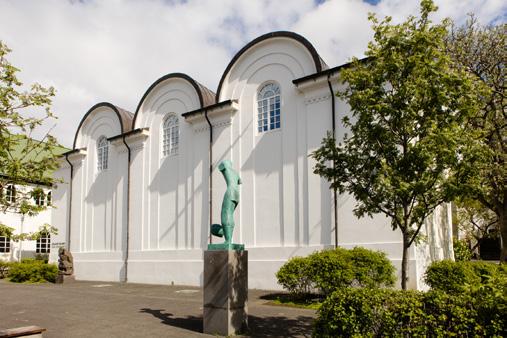
Iceland's leading art museum, established in 1884. Its collection consists mainly of 19th, 20th and 21st century art. The National Gallery possesses a coherent array of Icelandic works and a fine collection of international art. Together they constitute around 11,000 items.
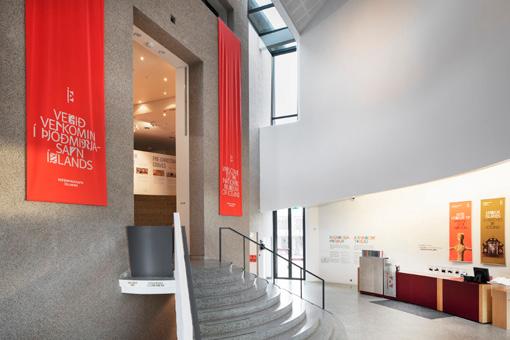
Offers state-of-the-art exhibitions on the cultural history of Iceland. The permanent exhibition, Making of a Nation - Heritage and History of Iceland, gives a comprehensive picture of Iceland’s cultural history through the ages to the present day.
Suðurgata 41, Reykjavík 530-2200 | www.nationalmuseum.is
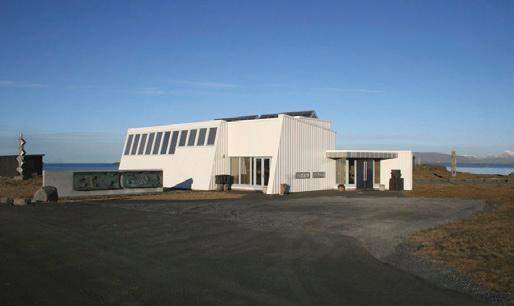
A museum that Icelandic sculptor Sigurjón Ólafsson’s wife founded as a tribute to his life and work in 1984. She had his studio in Laugarnes converted to an exhibition space to house his collection of works, including sculptures, sketches, drawings and biographical material.

Step into a mesmerizing world where molten earth meets artistic expression and scientific exploration. The Lava Show in Iceland invites you to witness the raw power and elegance of volcanic forces with the world’s only live lava show!
Fiskislóð 73, Reykjavík
553-0005 | icelandiclavashow.com
Hours: Tue-Sun: 10-17

Probably the most unique museum you’ll visit on your trip, the Icelandic Phallological Museum is one of a kind. Here you’ll find a collection of more than two hundred penises and penile parts belonging to almost all land and sea mammals that can be found in Iceland.
Hafnartorg, Reykjavík 561-6663 | www.phallus.is
Hours: Daily 10-19

This peculiar building, built on top of six water tanks on a hill overlooking the city, houses two exhibitions, The Wonders of Iceland and Water in Icelandic Nature. In addition, Perlan has a recently-opened planetarium, a café and gelateria, and an observation deck with a 360° view of the city and its surrounding nature.
Varmahlíð 1, Reykjavík 566-9000 | www.perlan.is
Hours: 9-22

FlyOver Iceland utilises state-of-theart technology to give you the feeling of flight. You will hang suspended, feet dangling, before a 20-metre spherical screen while the film whisks you away on an exhilarating journey across Iceland. Special effects, including wind, mist and scents, combine with the ride’s motion to create an unforgettable experience.
Fiskislóð 43, 101 Reykjavík. 527-6700. www.flyovericeland.is Hours: Mon-Fri, 11:00-19:00 & Sat-Sun, 11:00-19:00.
Laugarnestangi 70 553-2906 | www.lso.is
Hours: Closed in January

The Northern Lights Center, Aurora Reykjavik, allows you to experience the northern lights in a completely different way, both if you saw them, but as well if they escaped you while in Iceland. The centre features information, education and of course stunning visuals of the elusive lights that’ll get your heart racing.
Fiskislóð 53, Reykjavík 780-4500 | www.aurorareykjavik.is
Hours: Daily

Its objective is to collect, study and present Icelandic design and crafts from 1900 to the present day. This young museum, the only one of its kind in Iceland, holds regular exhibitions of Icelandic and international design during the year. Exhibitions from the museum‘s own collection are regularly held.
Garðatorg 1, Garðabær 512-1525 | www.honnunarsafn.is
Hours: Tue-Sun 12-17

Mainly devoted to paintings and sculpture by well-established Icelandic and international artists. Kjarvalsstaðir offers a permanent exhibition of key works by one of Iceland’s most beloved landscape painters, Jóhannes S. Kjarval, as well as changing exhibitions that explore various thematic and historical aspects of Icelandic art.
Flókagata 24, Reykjavík 411-6420 | www.artmuseum.is
Hours: Daily 10-17

Halldór Laxness is arguably the most famous Icelandic writer of all time, and the only Icelander to have won a Nobel Prize, which he received for literature in 1955. Gljúfrasteinn was his home until his death, and today it is a museum dedicated to his life and work.
Gljúfrasteinn, Mosfellsbær 586-8066 | www.gljufrasteinn.is
Hours: Tue-Fri 10-17

Opened in 1983, the collection is housed in a unique building designed and constructed mostly by the artist himself from 1942-1950. The original building served Sveinsson as studio and home; behind it he built a crescent-shaped structure as a work and exhibition space.
Sigtún, Reykjavík 411-6430 | www.artmuseum.is
Hours: Daily 10-17

FREE ENTRY Hafnarborg has a collection of Icelandic art and regular exhibitions presenting leading Icelandic and international artists. Collection exhibitions are a regular part of the program. Around exhibitions are workshops and guided tours.
Strandgata 34, Hafnarfjörður 585-5790 | www.hafnarborg.is
Hours: 12-17, closed on Tuesdays

A progressive modern art museum in Kópavogur, dedicated to sculptor Gerður Helgadóttir; the only museum in Iceland dedicated to a woman. Its collection consists of more than 1,400 works by Gerður, as well as the works of the most celebrated Icelandic artists of the 20th and 21st century.
Hamraborg 4, Kópavogur 441-7600 | www.gerdarsafn.is
Hours: Tue-Sun 10-17

House of collections was built in 1906 and for most of the 20th century served as the country’s National Library. The stately building currently houses the National Gallery’s exhibition Treasures of a Nation, displaying works from the Gallery’s extensive collection depicting Iceland’s art history from the early 19th century to our times.
Hverfisgata 15, Reykjavík 515-9600 | www.listasafn.is
Hours: Daily 10-17
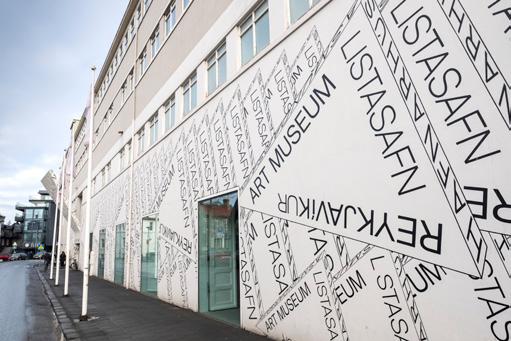
The old harbour warehouse, Hafnarhús, offers a progressive exhibition program with local and international contemporary artists. The work of current notables, art canons and newcomers is presented in six galleries. Hafnarhús is also home to the works of Erró (b. 1932), a significant player in the international pop art scene.
Tryggvagata 17, Reykjavík 411-6400 | www.artmuseum.is
Hours: Daily 10-17, Thu 10-22

An active exhibition space that has organized many exciting exhibitions throughout the years. They put an emphasis on introducing young Icelandic artists, as well as showcasing work by better-known Icelandic and foreign modern and contemporary artists.
The Marshall House Grandagarður 20, Reykjavík 551-4350 | www.nylo.is
Hours: Wed-Sun: 12-18

Iceland maintains strong ties to other Nordic countries, and the center of this cooperation is the Nordic House, designed by acclaimed Finnish architect Alvar Aalto in 1968. The Nordic House is the venue if you want to enjoy the best of Icelandic culture as well as experiencing rich culture of the Nordic countries.
Sturlugata 5, Reykjavík 551-7030 | www.nordice.is
Hours: Tue-Sun: 10-17












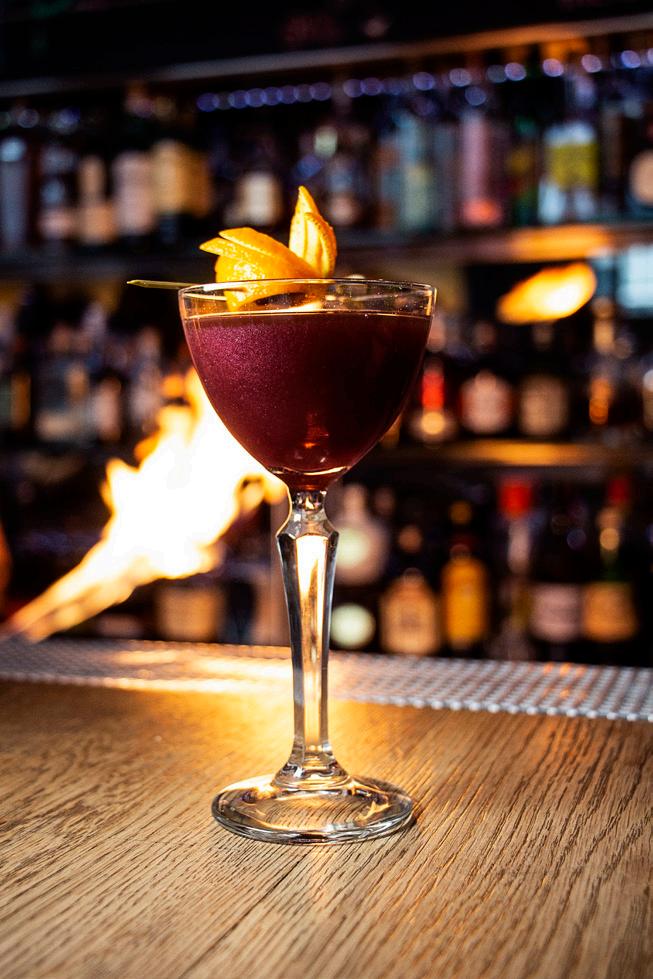






peckish after a few glasses of their delicious wines, they also serve snacks and small plates. The cosy bar is perfect for having a few glasses of wines with friends or a date.
Laugavegur 27, Reykjavík 888-2380

There’s nothing like an Einstök beer after a long day of exploring Reykjavíkand now there’s a whole bar dedicated to this popular brew! Einstök literally means unique and after a few sips of their refreshing craft ale, brewed with fresh water from Northern Iceland, we’re sure you’ll agree. The recently opened Laugavegur bar makes it even easier to enjoy their variety of ales, ranging from citrusy fresh white to the darkest of porters.
Laugavegur 10, Reykjavík


If you are visiting Iceland for the first time then you must stop by the Lebowski Bar. Open every day from 11AM, happy hour from 4-7PM, food served until 10PM, Quiz every Thursday (free entry), live sport events on 5 HD screens and Reykjavik nightlife every Friday & Saturday.
Laugavegur 20a, Reykjavík 552-2300 www.lebowski.is

Port 9 wine bar is a hidden gem just off the main shopping street. Serving selected wines and a unique blend of appetizers made with the freshest seasonal ingredients, Port 9 is one of the best spots in the city to stop by for a glass of quality wine in a relaxed atmosphere.
Veghúsastígur 9, Reykjavík 897-8212 www.port9.is

Beer enthusiasts look no further! near the top of Laugavegur, the city’s main shopping street, you will find Micro Bar. This ambitious bar serves only beer from microbreweries! Carrying an impressive 140 different kinds of beers from all over the world, this is definitely the go-to place for beer fans, and a nice place to spend an evening.
Laugavegur 86, Reykjavík
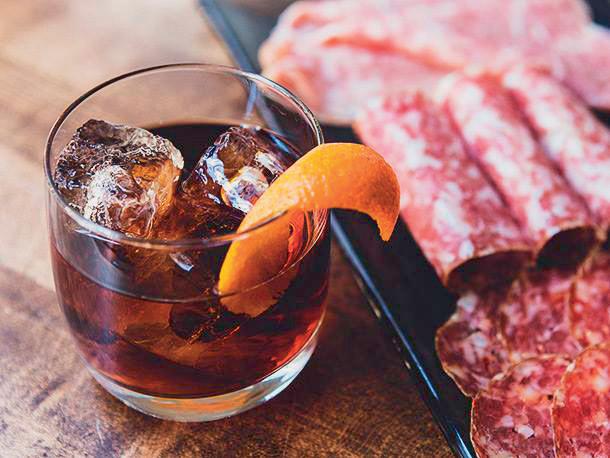
In the heart of the city, AUTO offers vibrant weekend parties with great music, premium bottle service, and a lively crowd. Whether you’re here to dance or just soak in the atmosphere, AUTO is your go-to spot for nightlife in Reykjavík. Open Friday and Saturday nights from 11 pm.
Lækjargata 2a, 101 Reykjavík www.autoclub.is

This hostel café/bar is bright and spacious; the perfect place to start the night. The hall hosts events most nights and on summer afternoons, the balcony is the best place in town for a beer in the sun. Last but not least, Loft has the best foosball table of all the bars in the city centre.
Bankastræti 7, Reykjavík 553-8140

Kiki is the only queer bar in town these days but it is also the best one! If you’re worried you won’t find the place, don’t be. The rainbow coloured street entrance, stream of people in a dancing mood, and the far-off sound of dance-heavy beats should lead you where you want to go!
Laugavegur 22 www.kiki.is
In the early 20th century, Hverfisgata 12 was home to the country’s first X-ray clinic. Today, the building houses one of the city’s newest bars but the name pays homage to the building’s long history. Expect cocktails, natural wines, and the city’s artsiest crowd having a night out.
Hverfisgata 12, Reykjavík www. www.rontgenbar.is

An Irish-style pub in downtown Reykjavík. Happy hour every day from 12PM to 7PM! Guests can enjoy a game of darts, listen to live music Thursday to Sunday evenings, spin the wheel of fortune and you can even book a private karaoke room! Sláinte.
Klapparstígur 27, Reykjavík 581-2020
www.irishman.is

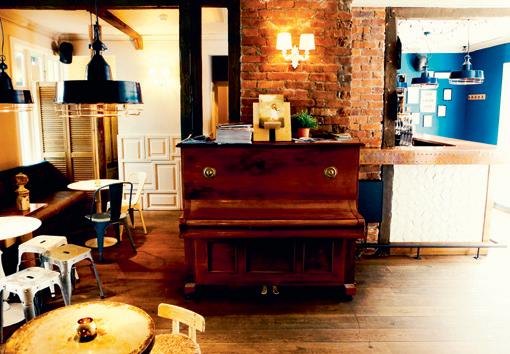
One of the coolest bars in Reykjavik these days is Kaldi Bar. In close cooperation with north Icelandic micro brewery of the same name, Kaldi offers you a selection of craft brewed beers on tap. Great happy hour and great fun, Kaldi is a place not to be missed!
Laugavegur 20b, Reykjavík 581-2200

Built in 1926 as an apartment, the Petersen Suite is one of Reykjavík’s hidden gems. Take the elevator up to the third floor above the historic Gamla Bíó concert hall to reveal an elegant bar with one of Reykjavík’s best views. On sunny days, you need to get there early, the sunny patio fills up quickly!
Ingólfsstræti 2a 3rd floor, Reykjavík 563-4000 | www.ktf.is

Best known as Damon Albarn’s hangout place back in the day, this most famous bar in Iceland is a popular destination for the artsy crowd. During the week it‘s more of a café, but on the weekend the volume rises and KB becomes one of the hottest bars in Reykjavik.
Bergstaðastræti 1, Reykjavík 551-1588 www.kaffibarinn.is
Uppi Bar offers upscale dining, wine and cocktails. The name Uppi refers to its location, upstairs above the renowned Fish Market Restaurant. You can expect the same exquisite attention to detail and delicious food, but in a casual bar setting, perfect for happy hour or a fancy start to a night out.
Aðalstræti 12, Reykjavík 571-8788

The bar Nína on Hverfisgata offers a low-key atmosphere where people can sit down to talk and watch main sporting events in between. Later at night when the live sports have finished, the lights are dimmed and the music volume increased to get the party started.
Hverfisgata 20, Reykjavík www.ninabar.is

American Bar is named appropriately since it’s an American Bar in Reykjavík, of the kind you’re probably familiar with from other countries: there are dudes, chicks and random university students partying to the latest MTV tunes. They specialize in American culture and entertainment.
Austurstræti 8, Reykjavík 571-9999

This homey pub with a Danish theme is popular among locals. Happy hour every day from 4-7pm and live music with talented Icelandic musicians every night. Beer bingo every month and other fun events! Located in the heart of the city centre.
Ingólfsstræti 3, Reykjavík 552-0070 www.danski.is
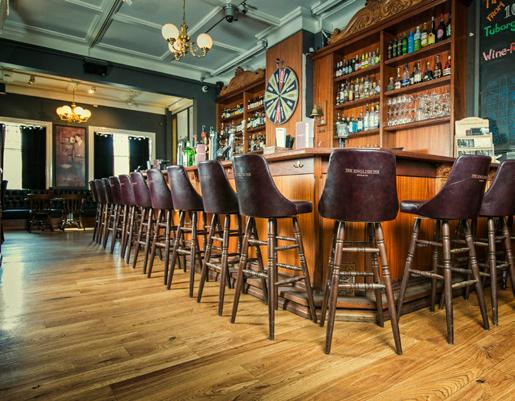
A popular pub in city centre. The English Pub offers happy hour every day from 4-7pm, live music every night, wheel of fortune and all major sport events are shown on 6 HD screens. Special events: Open Mic Tuesday, Guinness Thursday and Whisky Sunday.
Austurstræti 12, Reykjavík 578-0400 facebook.com/enskibarinn






A restaurant opposite the old harbour that offers traditional steak dishes along with some exciting and fairly unorthodox choices. The pride and joy of The Steakhouse is the Mibrasa charcoal oven, a rare oven that is designed to cook the perfect steak by mixing modern technology with ancient tradition.
Tryggvagata 4-6, Reykjavík 561-1111 | www.steik.is

Looking out over the Nauthólsvík beach, this charming Scandinavianinspired bistro is the perfect oasis from the stress of the everyday. Whether you’re there for a light lunch, a glass of wine on a sunny afternoon, a cup of hot coffee on a cold one, or a lovely dinner with a loved one, Nauthóll is the place to go.
Nauthólsvegi 106, 101 Reykjavík 599-6660 | www.nautholl.is

This trendy restaurant overlooking Austurvöllur square serves light and delicious food, inspired by French and Italian cuisine. The duck dishes are highly recommended but whatever you do, don’t forget to order one of their expertly mixed cocktails!
Austurstræti 14 101 Reykjavík 551 1020 |

Italian restaurant Hornið is a Reykjavík restaurant institution at this point, having opened in 1979. Situated in downtown Reykjavík, it was the first Italian restaurant in town and is as strong as ever. Expect fresh pizza, made right in front of the guests in the open kitchen. The cosy place is also a decent spot for people watching, with its large windows.
Hafnarstræti 15, Reykjavík 551-3340 I www.hornid.is

The Icelandic Bar is very aptly named: it is an Icelandic bar. But more than that, it is a bar that aims to preserve the essence of being Icelandic by combining the historical and cultural heritage of this ancient land with the very hip and cutting edge culture of modern times.
Ingólfsstræti 1a, Reykjavík 517-6767
scandinavian bistro
reason to stop by is for the selection of — Opið 1 :1 54 — 00:32 — nepO 1 1:45 — 23:00


Grandi Mathöll is a must visit for foodies. Situated in the hip Grandi area, the European style food hall has everything from fresh salmon ceviche to Vietnamese spring rolls and Korean tacos. Right next door is one of Iceland’s busiest harbours, and visitors can see a feed of live ship arrivals.
Grandagarður 16, Reykjavík 577-6200 | www.grandimatholl.is

Situated right downtown in Austurstræti, Laundromat houses laundry facilities and a family-friendly environment. A spacious recreational room downstairs will keep your children busy while you’re chomping on the bistro menu. Whether it’s brunch, board games or beer you’re looking for, Laundromat should have you covered.
Austurstræti 9, Reykjavík

Situated in downtown Reykjavík, the Spanish style bodega Tapas barinn is a place bursting with the delicious smells and flavours of traditional tapas along with the best of Icelandic tapas. Lining the wall are racks of fine wines and sparking glasses.
Vesturgata 3b, Reykjavík 551-2344 | tapas.is
With a new spin on traditional Icelandic

of local beer, Forréttabarinn – “The Starters Bar” – is worth seeking out when you need a bite to eat or a place to start your night out in Reykjavík. Whatever you choose from the refreshingly creative menu, you’re in

KRYDD is an à la carte restaurant that offers a dinner and lunch menu, along with appetizers and a state of the art cocktailbar. On Sundays, it offers a brunch buffet between 11:00 AM - 3:00 PM.
Hafnarborg, Strandgötu 34, Hafnarfjörður www.kryddveitingahus.is
Open: M-T 11-23, F-S, 11-01, S 11-23

Hlemmur Mathöll is a European style food hall featuring global delicacies alongside tasty Icelandic dishes. A former bus station, Hlemmur is now the new home for gourmands and fast food lovers alike in Reykjavík. Hlemmur brims with life on both weekends and weekdays alike, so head on down to see what the fuss is about.
Laugavegur, Reykjavík 787-6200 | www.hlemmurmatholl.is

mushy peas and malt vinegar with it! Splendid!
Grandagarður 37-9, Reykjavík 840-4100 | fishandchipsvagninn.is


JÓMFRÚIN

An open-sandwich restaurant in the Danish tradition offering authentic Danish smørrebrød along with a selection of hot dishes. The restaurant is located in the heart of the city centre and seats 80 guests. It is a popular lunch venue, especially with people from the business sector.


courses with Icelandic ingredients in classic recipes that all Icelanders are familiar with. The atmosphere is cosy with a fancy design that highlights fishing and seamanship.
Frakkastígur 8, Reykjavík 571-9800 www.mar-seafood.is

Grazie Trattoria is a casual but elegant Italian eatery conveniently located right off of Hverfisgata, a main street in downtown. Enjoy all of your Italian favourites, including pizza, pasta, seafood, good wine, and more!
Hverfisgata 96, Reykjavík 475-1555 | www.grazietrattoria.is
BÆJARINS BEZTU
Bæjarins Beztu Pylsur literally means The Town’s Best Hot Dogs. A must try while visiting, it is the perfect on-the-go food. We dare you to time the hot dog artists at Bæjarins Beztu after you order ‘ein með öllu’ (one with everything). They are incredibly quick to make a concoction of raw onions, fried onions, ketchup, remoulade, Icelandic mustard and the dog itself.
Tryggvagata 1, 101 Reykjavík 511-1566 | www.bbp.is



One of Iceland’s most treasured restaurants has made a comeback. The Italian delicacies of La Primavera are here to stay. Situated in the Marshall building, a former fishing warehouse, the building is also home to an art gallery, an art studio and the Living Art Museum.
Grandagarður 20, Reykjavík 519-7766 www.laprimavera.is


Fjallkonan is a lively restaurant & pub in the heart of Reykjavík offering a selection of Icelandic dishes made with fresh locally sourced Icelandic ingredients and delicious desserts made with Icelandic candy.
Hafnarstræti 1- 3, 101 Reykjavík 555-0950 www.fjallkona.is

Monkeys is an exciting restaurant offering Nikkei cuisine, a fusion of Japanese recipes and traditions with Peruvian ingredients. Exciting flavours of miso, ginger, soy, wasabi, and rice vinegar are mixed with quinoa, bell peppers, Andean potatoes, and corn, in a beautiful setting that creates just the right atmosphere. A great addition to the Reykjavík culinary scene!
Klapparstígur 30, 101 Reykjavík 519-5350 | www.monkeys.is

This Irish-bar looking restaurant is one of the city’s best places to sit down for a quick lunch and end up whiling away a whole afternoon in the cosy booth while the game is on or on the sunny patio. The weekend-bottomless brunch is particularly popular. so make sure to get a reservation!
Vegamótastígur 4, Reykjavík 558-0800 www.bastardbrewandfood.is

Hafnartorg Gallery, located by Reykjavík’s old harbour and across from the modern Harpa concert hall, is one of the latest editions to fine but casual dining downtown. With adjacent shops and art galleries nearby, sample artisanal pizzas, poke bowls, or a classic steak frites. Hafnartorg Gallery also offers a full-feature bar with beer on tap, wine, and a variety of cocktails.
Hafnartorg, Reykjavík www.hafnartorggallery.is

Quality, fusion and fun are the Fish Company’s main characteristics. The interior is stylish and the quirky tableware fits in wonderfully. The menu is a world of adventures from starters to deserts. It’s designed to take you on a seafood journey and not only a journey of the Icelandic culinary waters but a trip around the world.
Vesturgata 2a, Reykjavík 552-5300 | www.fiskfelagid.is

Tres Locos is a fun and lively Mexican restaurant located in Hafnarstræti 4, Reykjavík. The decor is colourful and full of curiosities and and the atmosphere vibrant and lively. Tres Locos serve taco, tostadas, fajitas, quesadilla and other Mexican delicacies, made with fresh Icelandic ingredients.
Hafnarstræti 4, 101 Reykjavík www.treslocos.is

Hop lovers, rejoice! UK’s Craft Beer Phenomenon just opened a bar and restaurant in downtown Reykjavik, located at the corner of Hverfisgata and Frakkastigur. Featuring 20 taps including BrewDog’s headliners, seasonals and one off brews as well as great local Icelandic craft beers. Highly impressive food menu and a very cosy atmosphere.
Frakkastígur 8, Reykjavík www.brewdog.com

Head out to Brauð & Co. to get your hands on the scrumptious sourdough bread and tasty cinnamon buns. The early bird gets the worm, so don't be late! Keep in mind that the queue can get quite long, but it's well worth it.
Opens early, closes at 18:00.
Frakkastígur 16, Reykjavík Fákafen 11, Reykjavík www.braudogco.is
IF YOU NEED MORE INFO, CONTACT INFO@WHATSON.IS
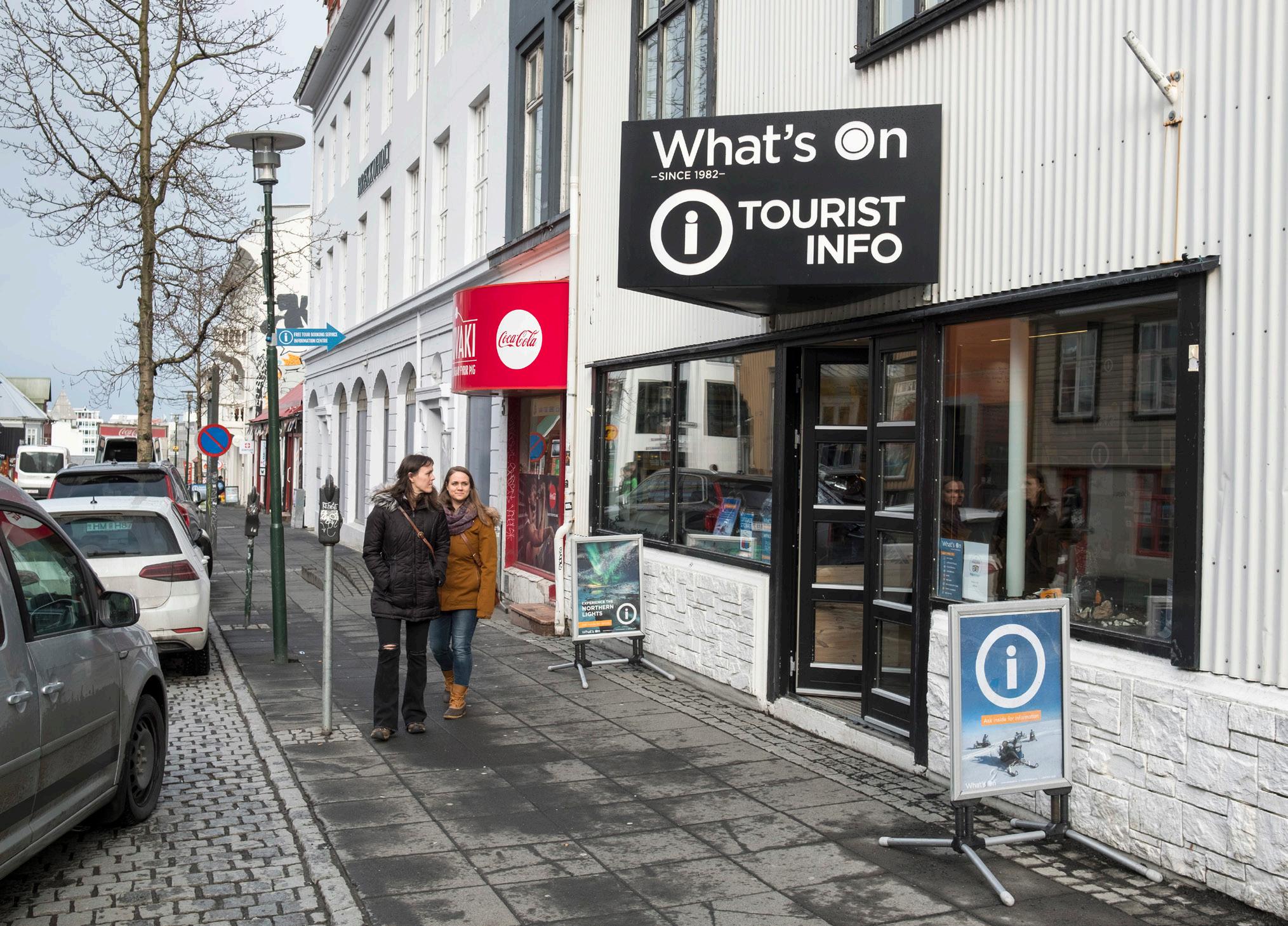
Strætó is the Icelandic bus company, and their yellow buses are easy to spot around the city. You have three ways to pay. With a top up KLAPP card, with the KLAPP app, and with KLAPP ten, a bus pass with ten tickets. You can buy KLAPP cards and KLAPP ten at selected gas stations, convenience stores, museums, and swimming pools. For more information, go to https://www.klappid.is/en/sales
Iceland’s international airport is located in Keflavík, about 50km from Reykjavík. If you rent a car or take a cab, it will take about 45 minutes to get to Reykjavík. A cheaper but just as reliable option is taking a bus to and from the airport. They connect to flights and will drop you off or pick you up at bus stops close to your accommodation in Reykjavík.
Iceland has its own currency, the Icelandic króna (ISK). It’s best to get króna at any bank (open Monday to Friday, 9-4), including the one at the Keflavík International Airport (open 24/7). You can either exchange money or go to an ATM to get cash. Credit card and debit card payments are widely accepted in Iceland.
There are different parking zones which charge different rates. Look for a parking sign (the familiar big P) indicating zones 1-4 and parking garages. Look for the nearest black terminal to pay, with cash or card, and type in your car’s number plate, no ticket necessary!
Getting an Icelandic SIM card is easy, you can get them at the airport, phone companies, and, of course, the What’s On tourist information centres at Laugavegur 5 and Laugavegur 54.
There are 18 swimming pools in the capital area and if you have the time, you should try them all. Swimming is great, but don’t miss relaxing in the hot tubs – this is where the community gathers and socialises. If you haven’t packed a bathing suit, you can rent one at the pool.
Visit our What’s On tourist information offices at Laugavegur 5 and Laugavegur 54 or contact us at info@whatson.is.
